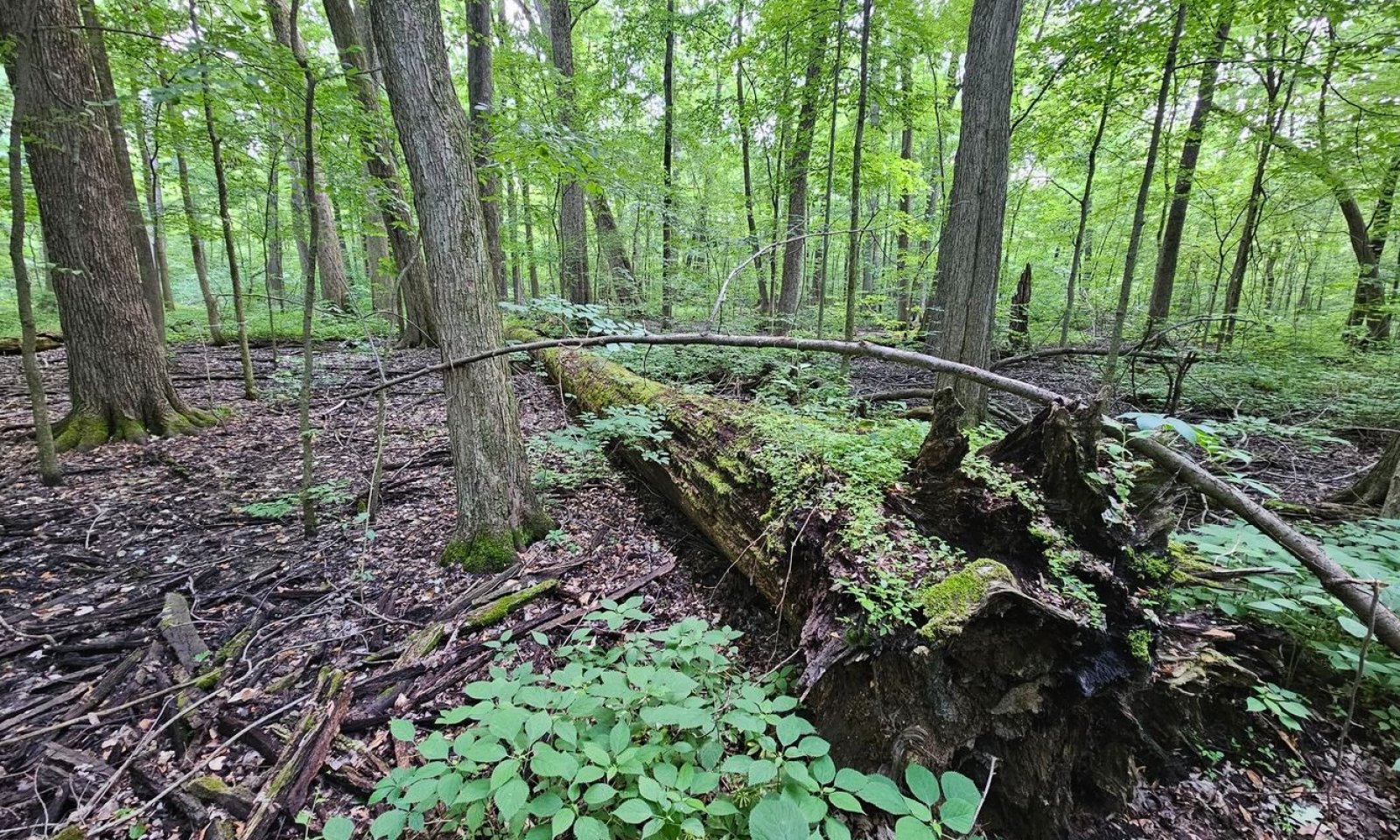

Natural Resources
Conservation Service
Ecological site F099XY013MI
Wet Lake Plain Flats
Last updated: 6/04/2024
Accessed: 04/08/2025
General information
Provisional. A provisional ecological site description has undergone quality control and quality assurance review. It contains a working state and transition model and enough information to identify the ecological site.
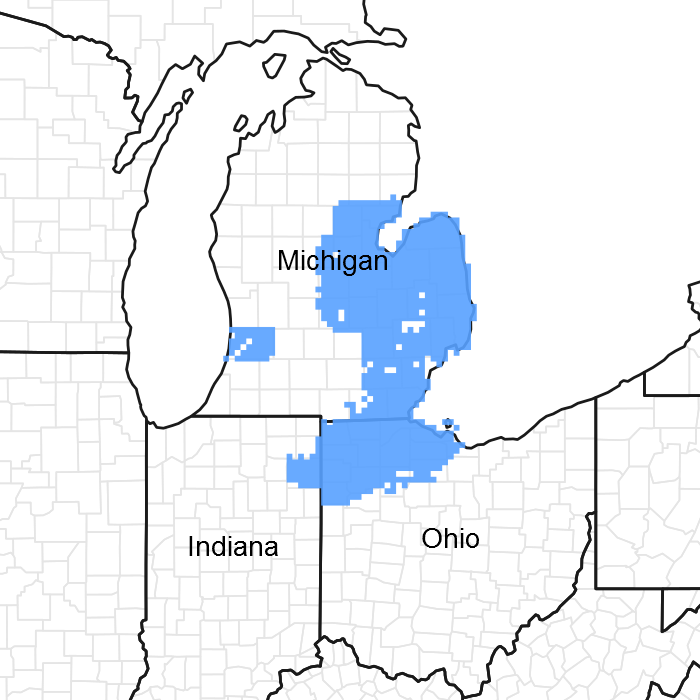
Figure 1. Mapped extent
Areas shown in blue indicate the maximum mapped extent of this ecological site. Other ecological sites likely occur within the highlighted areas. It is also possible for this ecological site to occur outside of highlighted areas if detailed soil survey has not been completed or recently updated.
MLRA notes
Major Land Resource Area (MLRA): 099X–Erie-Huron Lake Plain
This area is in the Eastern Lake Section of the Central Lowland Province of the Interior Plains (USDA-NRCS, 2022). It is a nearly level glacial lake plain with a few scattered ridges of sand that represent past shorelines and moraines. The Saginaw, Clinton, and Huron Rivers empty into the Great Lakes in the part of the area in Michigan. The southern half of this area is covered with glacial deposits of till, lake sediments, and outwash from the Wisconsin and older glacial periods. The area also has some low moraines. Mississippian- to Silurian-age shale, limestone, and dolomite rocks are at or near the surface close to Lake Erie and Lake Huron. Sandstone comes near the surface in the Thumb area east of Saginaw Bay, and a sandstone headland exists on a short stretch of Lake Huron shoreline. An extensive swamp in proximity the Maumee River prevented overland travel prior to its drainage by early settlers. Remnant marshes are near the Lake Erie shore.
The dominant soils in this MLRA are Alfisols, Inceptisols, Mollisols, and Spodosols. The soils in the area dominantly have a mesic soil temperature regime, an aquic soil moisture regime, and mixed or illitic mineralogy. Most soils in MLRA 99 are very deep, generally somewhat poorly drained to very poorly drained, and loamy or clayey. Epiaqualfs (Blount, Hoytville, Nappanee, and Shebeon series) and Glossudalfs (Capac series) formed in till (some of which is dense) on till plains, moraines, and lake plains. Epiaquepts formed in loamy till on till plains and moraines (Kilmanagh series) and in lacustrine deposits on lake plains (Lenawee and Paulding series). Endoaquepts formed in lacustrine deposits on lake plains (Latty and Toledo series) and in loamy till on moraines (Parkhill series). Endoaquolls formed in outwash deposits on outwash plains and lake plains, in drainageways (Granby series), and in loamy till on till plains and moraines (Tappan series). Endoaquods (Pipestone series) formed in outwash deposits on outwash plains, lake plains, and beach ridges. Epiaquods (Wixom series) formed in sandy sediments over till or lacustrine deposits on till plains, outwash plains, and lake plains.
Broad flat areas of somewhat poorly drained soils support Landfire (2017) systems: North-Central Interior Beech-Maple Forest, with wetter patches of North-Central Interior Wet Flatwoods, and Central Interior and Appalachian Swamp. Sandy beach ridges and thin sand flats have Landfire (2017) systems: North-Central Interior Dry-Mesic Oak Forest and Woodland and Great Lakes Wet-Mesic Lakeplain Prairie. Central Interior and Appalachian Floodplain Systems occur adjacent to rivers that flow through the area. To the north, oak systems decline in coverage. Thin sandy flats in the north have Laurentian-Acadian Pine-Hemlock-Hardwood Forest. The north and south are best separated as ecological inference areas due to floristic and dominant vegetation contrasts which also correspond to generally lower summer and winter temperatures northward. This north-south break is approximated by the drainage divide between the Lake Huron and Lake Erie/Lake St. Clair basins.
Nearly three-fourths of this MLRA is in farms. About three-fifths of the area is cropland. The rest of the farmland is mostly in small farm woodlots, but some of the farmland is used for permanent pasture or other purposes. Cash crops are important. Corn, winter wheat, soybeans, and hay are the major crops. Sugar beets and canning crops also are important. Some fruit and truck crops are grown on the coarse textured soils. Dairying is an important enterprise on some farms near the larger cities. Almost one-fifth of the area is used for urban development. Shiawassee National Wildlife Refuge, Cedar Point National Wildlife Refuge, Oak Openings Preserve Metropark (Ohio) are among the more notable conservation lands.
Summary of existing land use (South):
Upland Forest (7%)
Hardwood (6%)
Agricultural (60%)
Developed (28%)
Summary of existing land use (North):
Upland Forest (14%)
Hardwood (13%)
Agricultural (58%)
Developed (13%)
Swamps and Marshes (13%)
Classification relationships
The USFS ecoregion classification (Cleland et al., 2007) for the majority of MLRA 99 is the Humid Temperate, Hot Continental Division, Midwest Broadleaf Forest Province 222, Lake Whittlesey Glaciolacustrine Plain Section 222U. The ecoregion subsection composition is 222Ud (Sandusky Lake Plain) and 222Ue (Saginaw Clay Lake and Till Plain) in the north near Lake Huron and Saginaw Bay. In the south near Lake Erie, the area is composed of subsections 222Ua (Maumee Lake Plain), 222Ub (Paulding Plains), and 222Uc (Marblehead Drift/Limestone Plain). A mix of interlobate deposits extends into MLRA 99 as subsection 222Jf (Lum Interlobate Moraine) of South Central Great Lakes Section 222J. Sandy deposits extend south from adjacent MLRA are part the Warm Continental Division, Laurentian Mixed Forest Province 212, Northern Lower Peninsula Section 212H, subsection 212Hh (Gladwin Silty Lake Plain).
The Saginaw Bay and Lake Huron lake plains is coextensive with EPA ecoregion 57e (Saginaw Lake Plain) (Omernik and Griffith, 2014). The majority of the Lake Erie or Maumee Lake Plain includes EPA ecoregion 57a (Maumee Lake Plain), extending east to include 57d (Marblehead Drift/Limestone Plain). Large inclusions of sand are delineated as ecoregion 57b (Oak Openings). A significant area of higher clay is designated as 57c (Paulding Plains).
Ecological site concept
The central concept of the Wet Lake Plain Flats is loamy to clayey wave worked till and lacustrine deposits with a persistently high water table, often with a horizon of very low saturated hydraulic conductivity within 100 cm of the surface. Site is generally found in depressions or extensive flats and is poorly drained or very poorly drained. Due to very low saturated conductivity, some depressional locations are subject to ponding from local rainfall events, but with little groundwater input. Therefore vegetation is potentially similar to that of a floodplain forest in that it is subject to periodic inundation followed by periods of dryness.
Associated sites
| F099XY007MI |
Lake Plain Flats |
|---|
Similar sites
| F098XA012MI |
Wet Loamy Depressions |
|---|
Table 1. Dominant plant species
| Tree |
(1) Acer saccharinum |
|---|---|
| Shrub |
(1) Cephalanthus occidentalis |
| Herbaceous |
Not specified |
Physiographic features
Site occurs on extensive flats on wave reworked till or lacustrine deposits.
Table 2. Representative physiographic features
| Landforms |
(1)
Lake plain
(2) Flat |
|---|---|
| Runoff class | Negligible to low |
| Elevation | 174 – 273 m |
| Water table depth | 0 – 25 cm |
| Aspect | Aspect is not a significant factor |
Climatic features
This ecological site experiences a humid continental climate with mild summers and cold winters. Precipitation is moderately well distributed through the year with higher amounts during the growing season than the winter.
Temperature extremes are moderated in immediate proximity to the Great Lakes, but this moderation has minimal effect inland due to prevailing winds blowing mainly offshore. Mean annual extreme minimum temperatures range from -26.6 to -18.8 °C (-16 to -2 °F), which falls within hardiness zones 5a to 6a (USDA, 2009). In general, temperatures are cooler northward, though local city heat island effects may interrupt this pattern.
The lack of significant topographic relief and general downwind direction to the Great Lakes likely contribute to this MLRA having lower annual precipitation and snowfall compared to the MLRA to the west. Mean annual snowfall ranges from 0.7 to 1.5 m (25 to 55 in). In general, snowfall is highest northward.
Table 3. Representative climatic features
| Frost-free period (characteristic range) | 128-147 days |
|---|---|
| Freeze-free period (characteristic range) | 158-186 days |
| Precipitation total (characteristic range) | 20,650-22,581 mm |
| Frost-free period (actual range) | 113-154 days |
| Freeze-free period (actual range) | 146-189 days |
| Precipitation total (actual range) | 20,650-23,876 mm |
| Frost-free period (average) | 136 days |
| Freeze-free period (average) | 171 days |
| Precipitation total (average) | 21,946 mm |
Figure 2. Monthly precipitation range
Figure 3. Monthly minimum temperature range
Figure 4. Monthly maximum temperature range
Figure 5. Monthly average minimum and maximum temperature
Figure 6. Annual precipitation pattern
Figure 7. Annual average temperature pattern
Climate stations used
-
(1) MT CLEMENS ANG BASE [USW00014804], Harrison Township, MI
-
(2) GLADWIN [USW00014828], Beaverton, MI
-
(3) ALMA [USC00200146], Alma, MI
-
(4) MONROE [USC00205558], Monroe, MI
-
(5) SAGINAW #3 [USC00207222], Saginaw, MI
-
(6) PANDORA [USC00336405], Pandora, OH
-
(7) PAULDING [USC00336465], Paulding, OH
-
(8) TIFFIN [USC00338313], Tiffin, OH
-
(9) SAGINAW MBS INTL AP [USW00014845], Freeland, MI
-
(10) ESSEXVILLE [USC00202631], Bay City, MI
-
(11) STANDISH 5SW [USC00207820], Bentley, MI
-
(12) YALE 1 NNW [USC00209188], Yale, MI
-
(13) FINDLAY WPCC [USC00332791], Findlay, OH
-
(14) SANDUSKY [USW00014846], Sandusky, OH
-
(15) TOLEDO EXPRESS AP [USW00094830], Monclova, OH
-
(16) BAD AXE [USC00200417], Bad Axe, MI
-
(17) CASS CITY 1 SSW [USC00201361], Cass City, MI
-
(18) MIDLAND [USC00205434], Midland, MI
-
(19) FREMONT [USC00332974], Fremont, OH
-
(20) FREMONT AG STN [USC00332976], Fremont, OH
-
(21) NAPOLEON [USC00335669], Napoleon, OH
-
(22) DETROIT METRO AP [USW00094847], Romulus, MI
-
(23) CARO WWTP [USC00201299], Caro, MI
-
(24) DEARBORN [USC00202015], Dearborn, MI
-
(25) SANDUSKY [USC00207350], Sandusky, MI
-
(26) HOYTVILLE 2 NE [USC00333874], Cygnet, OH
-
(27) WAUSEON WTP [USC00338822], Wauseon, OH
Influencing water features
Site has seasonal high water table within 0-25 cm of the surface. Some sites may have a perched water table or ponding due to the impermeability of finer textures.
Soil features
Soils are poorly drained to very poorly drained fine loam and clay. They are commonly classified Mollic Epiaquepts, Mollic Epiaqualfs, and Typic Epiaquolls, and commonly mapped as Hoytville, Parkhill, and Tappan series or components.
Table 4. Representative soil features
| Parent material |
(1)
Lacustrine deposits
(2) Till |
|---|---|
| Surface texture |
(1) Loam (2) Clay |
| Drainage class | Poorly drained to very poorly drained |
| Permeability class | Very slow to moderately rapid |
| Soil depth | 201 cm |
| Surface fragment cover <=3" | 0 – 1% |
| Surface fragment cover >3" | 0% |
| Available water capacity (0-100.1cm) |
13 – 22 cm |
| Soil reaction (1:1 water) (0-50cm) |
5.5 – 7 |
| Subsurface fragment volume <=3" (0-150.1cm) |
0 – 35% |
| Subsurface fragment volume >3" (0-150.1cm) |
0 – 15% |
Ecological dynamics
The reference community of Wet Lake Plain Flats is swamp forest dominated by Acer saccharinum (silver maple), Fraxinus pennsylvanica (green ash), Ulmus americana (American elm), Quercus bicolor (swamp white oak), and Populus deltoides (eastern cottonwood), with an understory of Onoclea sensibilis (sensitive fern), Carex grayi (Gray's sedge), Glyceria striata (fowl mannagrass), and Boehmeria cylindrica (smallspike false nettle). Quercus shumardii (Shumard's oak) is an uncommon, but distinctive associate of the reference swamp forest community in the southern half of the extent of this ecological site concept in southeast Michigan and northwest Ohio (Kost et al., 2010). The high fertility and seasonal ponding of this mineral soil site results in a species composition similar to that of floodplains. Wet anoxic soils favor facultative and obligate wetland species.
Hydrology affects the spatial zonation while changes in precipitation patterns and beaver flooding affects community dynamics. Windthrow is a frequent disturbance due to shallow rooting of tree in wet soils, but usually consists of single tree gaps, favoring the already established young, mainly intermediate to shade tolerant species to fill the gaps. Fire occurs infrequently in swamp forest where fuels are typically discontinuous, and adjacent uplands are mesophytic forest. In some landscape settings adjacent to oak savanna, fires may carry into a wet meadow community phase. The degree of permeability of deeper soil layers affects the degree to which the hydrology is dominated by a steady water table or more subjected to short term droughts and surface runoff events.
The speed of succession in wet meadows and shrub thickets is slowed by wet hydrology. But because these sites are only seasonally wet, most instances of open communities in this ecological site will quickly succeed to swamp forest.
Sedge dominated wet meadow may dominate the site for the first 10 years after a tree and shrub mortality event such as from fire (every 1000 years) or ponding (every 300 years). Shrub thickets may dominate the site for up to 30 years before conversion to forest. Trees establishing under shrubs surpass the shrubs at 3-5 m tall. At 30-80 years, the canopy will exceed 10 m. In absence of disturbance the forest at 80-400 years may exceed 30 m tall. As a tree approaches the maximum height of the forest, it is at constant risk of being toppled by windthrow, especially with shallower rooting depths in hydric mineral soils (this effect is even worse for structurally weak organic soils). Shade intolerant and fast-growing species like Populus deltoides and Salix nigra may persist to 100 years, but earlier canopy emergence, lower density wood (increased wood-rot) all conspire to more quickly thin these species without replacement, due to shade. Longer lived trees may persist but will also tend to replace themselves with understory recruitment (advanced regeneration), having seedlings and saplings able to tolerate moderate amounts of shade. Upland species (e.g. species from adjacent upland forests: Acer saccharum, Tilia americana, Quercus rubra, Quercus macrocarpa, and Fagus grandifolia) may also be present on tip-up mounds, where roots are elevated above the water table. Transitional to wet sandy depressions and mucky depressions in more permeable substrates and less dynamic water tables, the overstory composition shifts towards species less tolerant of long period inundation such as Acer rubrum and Fraxinus nigrum.
For most of the flora there is a tradeoff between shade tolerance and flood tolerance (Niinemets and Valladares, 2006). Consequently, some of the species most tolerant of wetness are among the least shade tolerant. The hydric species Acer saccharinum, Fraxinus pennsylvanica, Ulmus americana, and Quercus bicolor are all intermediate in shade tolerance, but are the most tolerant among the hydric species (especially Acer saccharinum). Populus deltoides and most Salix spp. Cephalanthus occidentalis and Alnus rugosa are very shade intolerant. Acer saccharinum, Populus deltoides, Salix nigra, and Cephalanthus occidentalis can persist long periods in standing water. The understory of a ponded swamp forest tends to be sparse, whereas less inundated areas may have thick understory intermediately shade tolerant Lindera benzoin, Ilex verticillata, Zanthoxylum americanum, Sambucus canadensis, and Sambucus racemosa, species which may also occur in open shrub thickets. Open shrub thickets have a variable composition of shade intolerant shrubs: Cornus obliqua, Cornus racemosa, Cornus sericea, Salix interior, Salix petiolaris, Salix eriocephala, Salix sericea.
The seeds of swamp species often lack dormancy because they must be able to germinate mid-growing season while water tables are low, and not be washed away during the winter. Because the sites tend to maintain surface moisture throughout the growing season, seedlings of many genera (Acer, Fraxinus, Ulmus, and Populus) do not need the extra provisions for quickly establishing deep taproots, enabling a strategy of small, prolific winged fruits or seeds capable dispersing longer distances to smaller wetland patches. Nevertheless, the site supports the coexistence of the large-seeded genera (e.g. Quercus and Carya), as reproductive tradeoffs are not absolute.
Invasive plants like Frangula alnus, Alliaria petiolata, Berberis thunbergii, and Rosa multiflora have greatly affected the dominant species composition. More than a few percentages of these species render the stand semi-natural. The introduction of Dutch elm disease and emerald ash borer have substantially reduced the importance of Ulmus americana and Fraxinus pennsylvanica. It is common to find snags associated with dead Ulmus and Fraxinus, as well has extensive down woody debris in stands where dominance of Fraxinus was more recent. Ulmus has been able to sexually reproduce and maintain itself decades after the initial disease introduction. The current flux of Fraxinus seedlings and saplings is apparently remnant reproduction from trees that managed to reach maturity prior to arrival of the invasive borer.
State and transition model
More interactive model formats are also available.
View Interactive Models
Click on state and transition labels to scroll to the respective text
Ecosystem states
States 1 and 5 (additional transitions)
State 1 submodel, plant communities
Communities 2 and 5 (additional pathways)
State 2 submodel, plant communities
State 3 submodel, plant communities
State 4 submodel, plant communities
State 5 submodel, plant communities
State 1
Reference State
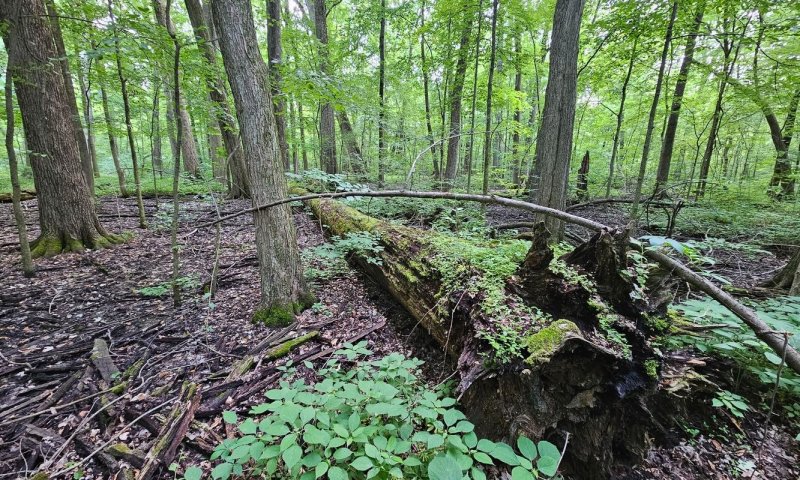
Dominant plant species
-
silver maple (Acer saccharinum), tree
-
American elm (Ulmus americana), tree
-
common buttonbush (Cephalanthus occidentalis), shrub
Community 1.1
Swamp Forest

Figure 8. Old growth swamp forest in Goll Woods State Nature Preserve, Fulton County, Ohio, rare remnant of the "Black Swamp" of northwestern Ohio.
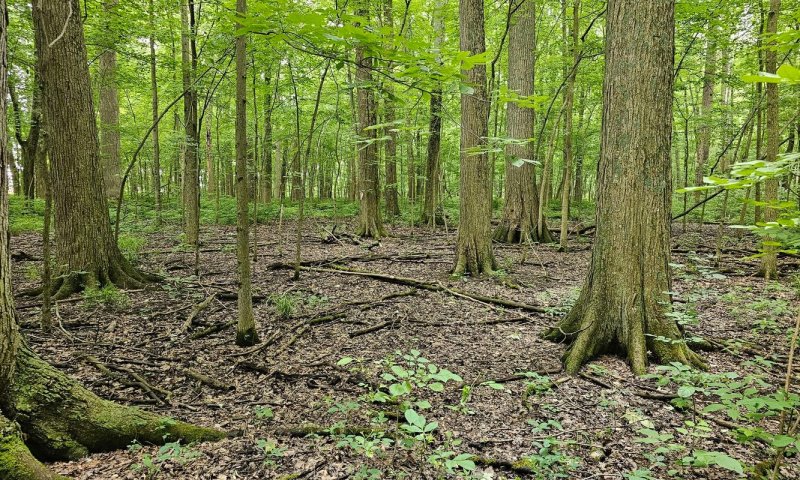
Figure 9. Old growth swamp forest in Goll Woods State Nature Preserve, Fulton County, Ohio, rare remnant of the "Black Swamp" of northwestern Ohio.
Dominant plant species
-
silver maple (Acer saccharinum), tree
-
American elm (Ulmus americana), tree
Table 5. Canopy structure (% cover)
| Height Above Ground (m) | Tree | Shrub/Vine | Grass/ Grasslike |
Forb |
|---|---|---|---|---|
| <0.15 | – | 0-1% | 0% | 0-4% |
| >0.15 <= 0.3 | 0-1% | 0-8% | 2-29% | 3-18% |
| >0.3 <= 0.6 | 0-1% | 0-7% | 1-29% | 2-13% |
| >0.6 <= 1.4 | 0% | 0-1% | – | – |
| >1.4 <= 4 | 0-12% | 0-6% | – | – |
| >4 <= 12 | 56-90% | 0-2% | – | – |
| >12 <= 24 | 65-91% | – | – | – |
| >24 <= 37 | 45-91% | – | – | – |
| >37 | – | – | – | – |
Community 1.2
Wet Meadow

Figure 10. Unspecified wet meadow showing representative variability in structure.
Table 6. Canopy structure (% cover)
| Height Above Ground (m) | Tree | Shrub/Vine | Grass/ Grasslike |
Forb |
|---|---|---|---|---|
| <0.15 | – | 0-1% | 31-75% | 16-47% |
| >0.15 <= 0.3 | – | 0-1% | 31-75% | 16-47% |
| >0.3 <= 0.6 | 16-48% | 1-4% | – | – |
| >0.6 <= 1.4 | 17-53% | 1-4% | – | – |
| >1.4 <= 4 | 5-15% | 0% | – | – |
| >4 <= 12 | 5-15% | – | – | – |
| >12 <= 24 | 5-15% | – | – | – |
| >24 <= 37 | – | – | – | – |
| >37 | – | – | – | – |
Community 1.3
Shrub-Thicket
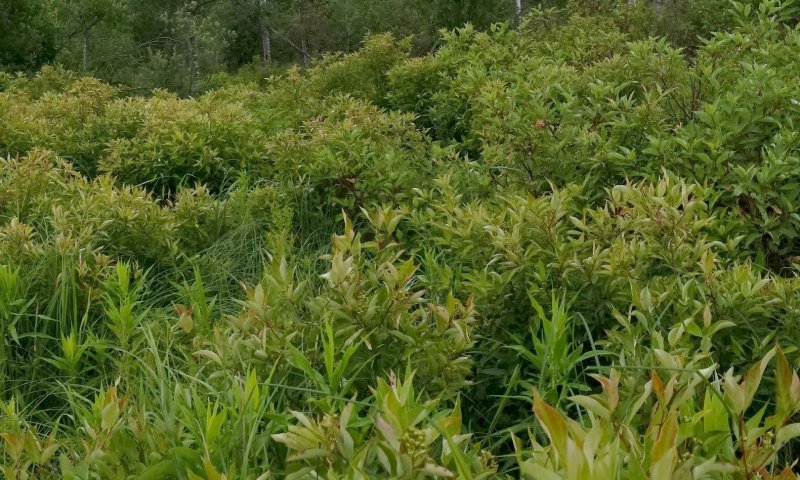
Figure 11. Unspecified shrub thicket showing representative structure.
Community 1.4
Emergent Marsh
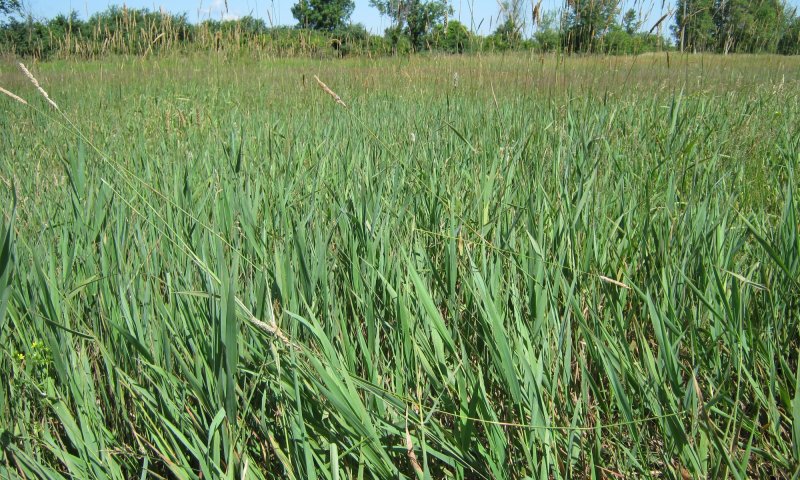
Figure 12. Unspecified marsh showing structure.
Dominant plant species
-
broadleaf cattail (Typha latifolia), grass
-
woolgrass (Scirpus cyperinus), grass
Community 1.5
Inundated Shrub Swamp
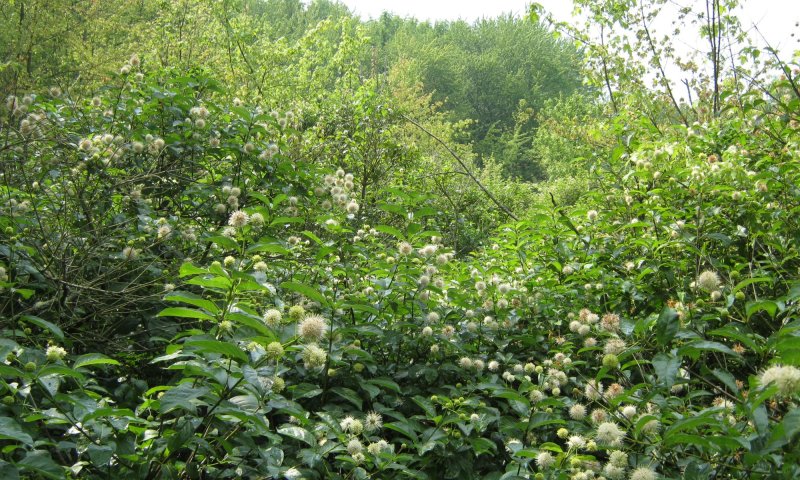
Figure 13. Unspecified inundated (button bush) shrub swamp showing representative structure.
Forest overstory. Overstory is minimal except as edge of adjacent forest stands.
Forest understory. Composition typically consists of Cephalanthus occidentalis.
Dominant plant species
-
common buttonbush (Cephalanthus occidentalis), shrub
Table 7. Canopy structure (% cover)
| Height Above Ground (m) | Tree | Shrub/Vine | Grass/ Grasslike |
Forb |
|---|---|---|---|---|
| <0.15 | – | – | – | 5-5% |
| >0.15 <= 0.3 | – | – | 2-2% | 5-5% |
| >0.3 <= 0.6 | – | – | 2-2% | – |
| >0.6 <= 1.4 | – | 95-95% | – | – |
| >1.4 <= 4 | – | 95-95% | – | – |
| >4 <= 12 | – | – | – | – |
| >12 <= 24 | – | – | – | – |
| >24 <= 37 | – | – | – | – |
| >37 | – | – | – | – |
Pathway 1.1A
Community 1.1 to 1.2


Temporary prolonged inundation.
Pathway 1.1B
Community 1.1 to 1.3


Clearcut/Blowdown.
Conservation practices
| Early Successional Habitat Development/Management | |
|---|---|
| Forest Stand Improvement |
Pathway 1.2A
Community 1.2 to 1.1


Succession.
Conservation practices
| Tree/Shrub Site Preparation | |
|---|---|
| Tree/Shrub Establishment |
Pathway 1.2B
Community 1.2 to 1.3


Succession.
Conservation practices
| Tree/Shrub Site Preparation | |
|---|---|
| Tree/Shrub Establishment |
Pathway 1.2D
Community 1.2 to 1.4


Permanent inundation.
Pathway 1.2E
Community 1.2 to 1.5


Shrub establishment; permanent inundation.
Conservation practices
| Tree/Shrub Establishment |
|---|
Pathway 1.3A
Community 1.3 to 1.1


Succession.
Conservation practices
| Tree/Shrub Site Preparation | |
|---|---|
| Tree/Shrub Establishment |
Pathway 1.3B
Community 1.3 to 1.2


Temporary prolonged inundation.
Pathway 1.3C
Community 1.3 to 1.4


Permanent inundation.
Pathway 1.3C
Community 1.3 to 1.5


Permanent inundation.
Pathway 1.4A
Community 1.4 to 1.2


Drop water table.
Pathway 1.4C
Community 1.4 to 1.5


Temporary drop water table; shrub establishment.
Pathway 1.5A
Community 1.5 to 1.2


Drop water table; shrub mortality.
Conservation practices
| Brush Management |
|---|
Pathway 1.5C
Community 1.5 to 1.4


Temporary drought; shrub mortality.
State 2
Cultural State
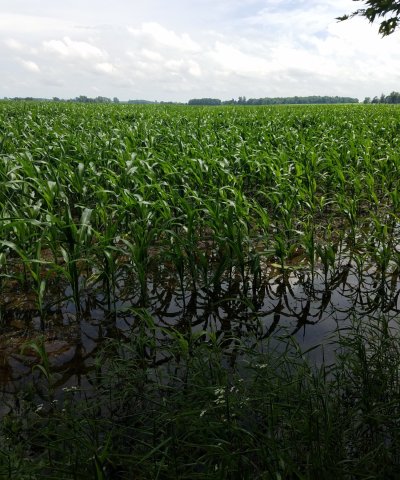
Community 2.1
Sustainable Crop, Pasture, or Plantation
Community 2.2
Unsustainable Cultural Phase
Community 2.3
Conservation Feature
Can be a grassed waterway, conservation reserve, a small patch pollinator garden, or other land taken out of its primary cultural production to mitigate or reduce impacts of adjacent land use, and is not by itself a permanent restoration of a complete native biological community and associated ecosystem services.
Pathway 2.1A
Community 2.1 to 2.2
Revert to unsustainable cultural practices.
Pathway 2.1B
Community 2.1 to 2.3
Establish conservation feature.
Conservation practices
| Conservation Cover | |
|---|---|
| Grassed Waterway |
Pathway 2.2A
Community 2.2 to 2.1
Implement sustainable cultural practices.
Conservation practices
| Conservation Crop Rotation | |
|---|---|
| Cover Crop | |
| Nutrient Management | |
| Integrated Pest Management (IPM) |
Pathway 2.2B
Community 2.2 to 2.3
Establish conservation feature.
Conservation practices
| Conservation Cover | |
|---|---|
| Grassed Waterway |
Pathway 2.3A
Community 2.3 to 2.1
Implement sustainable cultural practices.
Conservation practices
| Conservation Crop Rotation | |
|---|---|
| Cover Crop | |
| Nutrient Management | |
| Integrated Pest Management (IPM) |
Pathway 2.3B
Community 2.3 to 2.2
Revert to unsustainable cultural practices.
State 3
Seminatural Drained State
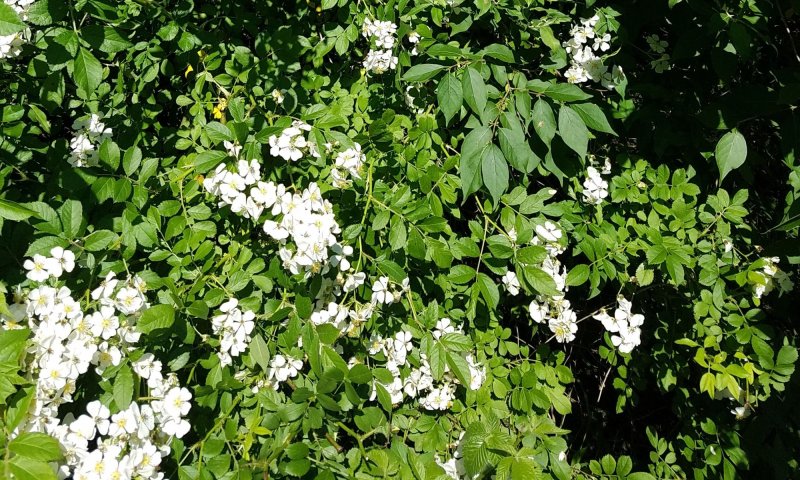
Community 3.1
Ruderal Drained Meadow & Shrub
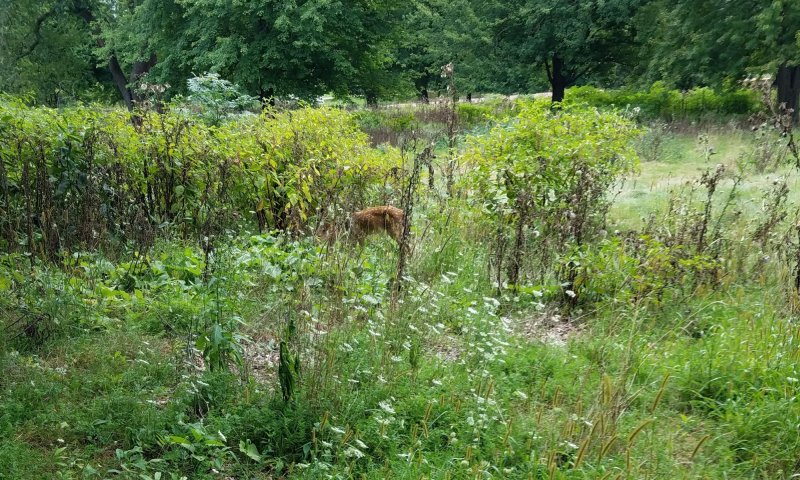
Figure 14. Ruderal drained meadow and shrub.
Table 8. Canopy structure (% cover)
| Height Above Ground (m) | Tree | Shrub/Vine | Grass/ Grasslike |
Forb |
|---|---|---|---|---|
| <0.15 | – | – | 0% | 0% |
| >0.15 <= 0.3 | 0% | – | 66-96% | 23-72% |
| >0.3 <= 0.6 | 0% | – | 66-96% | 23-72% |
| >0.6 <= 1.4 | 0-1% | – | – | – |
| >1.4 <= 4 | 0-1% | – | – | – |
| >4 <= 12 | – | – | – | – |
| >12 <= 24 | – | – | – | – |
| >24 <= 37 | – | – | – | – |
| >37 | – | – | – | – |
Community 3.2
Exotic Ruderal Drained Forest
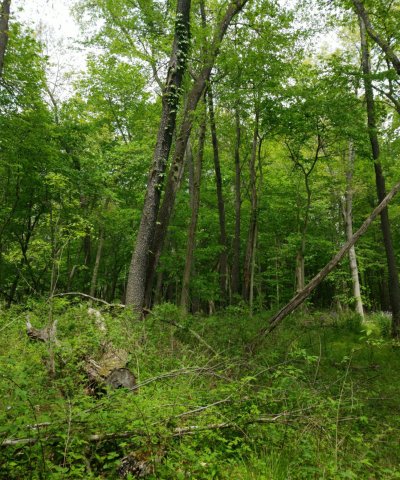
Figure 15. Exotic Ruderal Drained Forest
Table 9. Canopy structure (% cover)
| Height Above Ground (m) | Tree | Shrub/Vine | Grass/ Grasslike |
Forb |
|---|---|---|---|---|
| <0.15 | – | 0-3% | – | 0-6% |
| >0.15 <= 0.3 | 0-1% | 0-14% | 4-42% | 1-29% |
| >0.3 <= 0.6 | 0-1% | 0-5% | 4-42% | 1-20% |
| >0.6 <= 1.4 | – | 0-8% | – | – |
| >1.4 <= 4 | 0-17% | 11-49% | – | – |
| >4 <= 12 | 70-84% | 11-22% | – | – |
| >12 <= 24 | 60-75% | – | – | – |
| >24 <= 37 | 0-21% | – | – | – |
| >37 | – | – | – | – |
Pathway 3.1A
Community 3.1 to 3.2


Succession
Pathway 3.2A
Community 3.2 to 3.1


Blowdown/clearcut.
Conservation practices
| Early Successional Habitat Development/Management | |
|---|---|
| Forest Stand Improvement |
State 4
Seminatural State
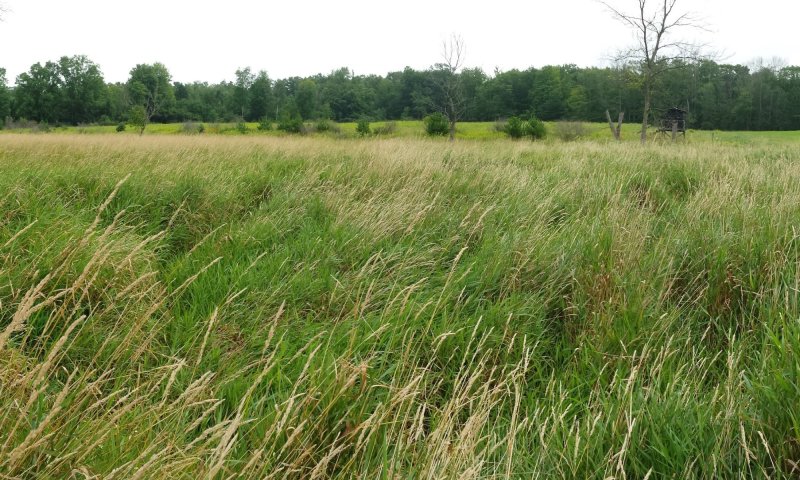
Community 4.1
Ruderal Wet Meadow & Shrub Swamp
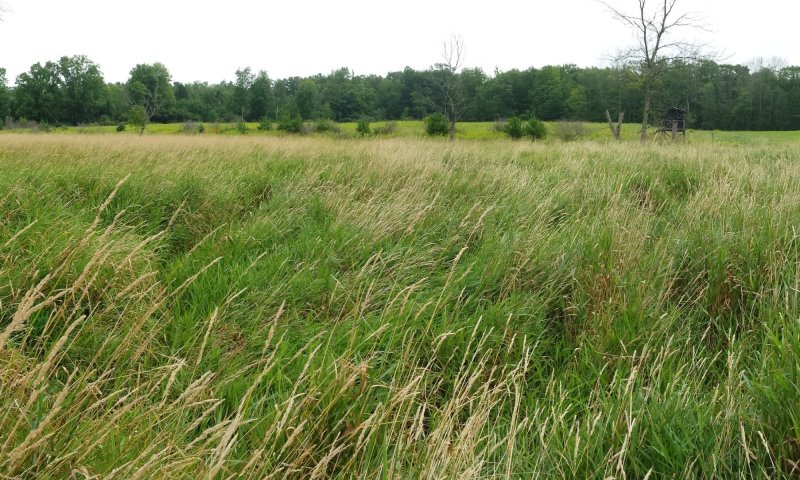
Figure 16. Representative reed canary grass wet meadow.
Table 10. Canopy structure (% cover)
| Height Above Ground (m) | Tree | Shrub/Vine | Grass/ Grasslike |
Forb |
|---|---|---|---|---|
| <0.15 | – | 0-1% | – | – |
| >0.15 <= 0.3 | 0% | 0-2% | 2-91% | 2-48% |
| >0.3 <= 0.6 | 0% | 0-1% | 76-96% | 11-64% |
| >0.6 <= 1.4 | – | 0-1% | 0-15% | 0-5% |
| >1.4 <= 4 | 0-4% | 0-13% | – | – |
| >4 <= 12 | 0-10% | 0-1% | – | – |
| >12 <= 24 | – | – | – | – |
| >24 <= 37 | – | – | – | – |
| >37 | – | – | – | – |
Community 4.2
Exotic Ruderal Swamp Forest
Table 11. Canopy structure (% cover)
| Height Above Ground (m) | Tree | Shrub/Vine | Grass/ Grasslike |
Forb |
|---|---|---|---|---|
| <0.15 | – | 13-13% | – | 1-1% |
| >0.15 <= 0.3 | 25-25% | 34-34% | – | 60-60% |
| >0.3 <= 0.6 | 25-25% | 24-24% | – | 60-60% |
| >0.6 <= 1.4 | – | 16-16% | – | – |
| >1.4 <= 4 | 13-13% | 20-20% | – | – |
| >4 <= 12 | 96-96% | 4-4% | – | – |
| >12 <= 24 | 95-95% | – | – | – |
| >24 <= 37 | – | – | – | – |
| >37 | – | – | – | – |
Pathway 4.1A
Community 4.1 to 4.2
Succession.
Pathway 4.2A
Community 4.2 to 4.1
Blowdown/clearcut.
Conservation practices
| Early Successional Habitat Development/Management | |
|---|---|
| Forest Stand Improvement |
State 5
Native Drained State
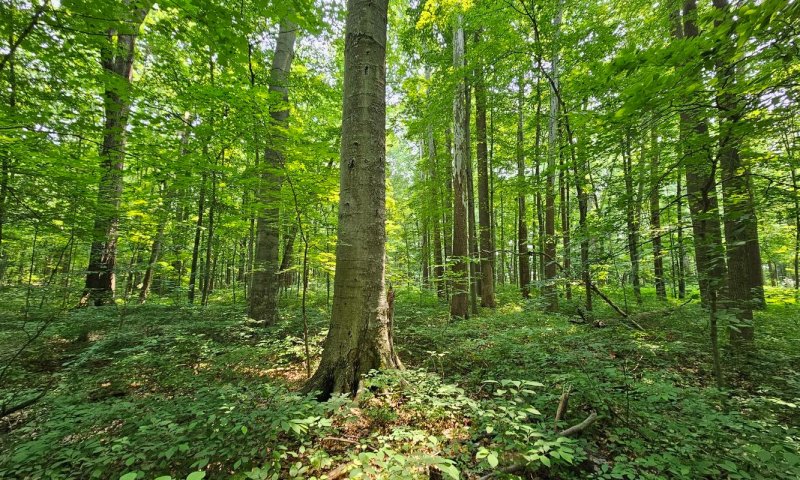
Community 5.1
Native Drained Forest
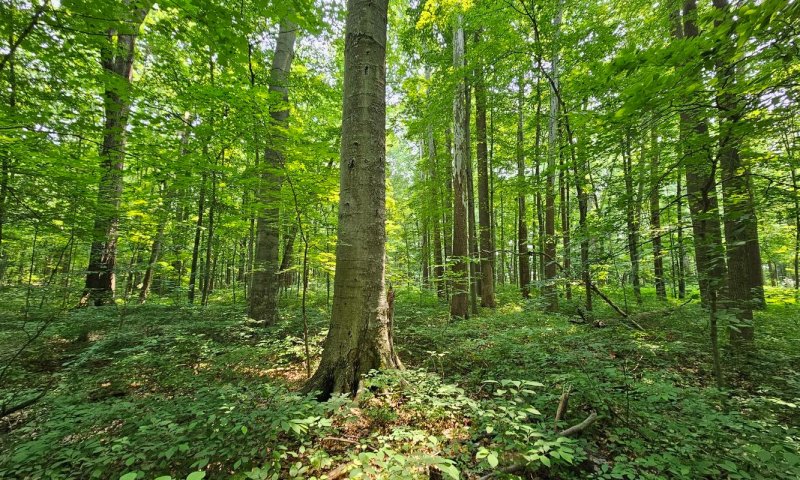
Figure 17. Mesophytic hardwood forest, hydrologically equivalent to native drained forest.
Transition T1A
State 1 to 2


Drain; clear vegetation; cultivate domesticated species.
Transition T1B
State 1 to 3


Drain; clear vegetation, invasive species introduced.
Transition T1C
State 1 to 4


Clear vegetation, invasive species introduced.
Transition T1D
State 1 to 5


Drain. Succession towards non-hydric shade tolerant species.
Restoration pathway R2
State 2 to 1


Restore hydrology; remove domesticated species; restore native species.
Conservation practices
| Brush Management | |
|---|---|
| Restoration and Management of Rare and Declining Habitats | |
| Wetland Wildlife Habitat Management | |
| Wetland Restoration | |
| Herbaceous Weed Control |
Transition T2A
State 2 to 3


Abandon, succession.
Transition T2B
State 2 to 4


Restore hydrology; abandon; succession.
Conservation practices
| Wetland Restoration |
|---|
Restoration pathway R3
State 3 to 1


Restore hydrology; control invasive species; restore native species
Conservation practices
| Brush Management | |
|---|---|
| Restoration and Management of Rare and Declining Habitats | |
| Wetland Wildlife Habitat Management | |
| Wetland Restoration | |
| Herbaceous Weed Control |
Transition T3A
State 3 to 2


Clear vegetation; cultivate domesticated species.
Transition T3B
State 3 to 4


Restore hydrology.
Conservation practices
| Wetland Restoration |
|---|
Restoration pathway R4
State 4 to 1


Control invasive species; restore native species.
Conservation practices
| Brush Management | |
|---|---|
| Restoration and Management of Rare and Declining Habitats | |
| Wetland Wildlife Habitat Management | |
| Herbaceous Weed Control |
Transition T4A
State 4 to 2


Drain; clear vegetation; cultivate domesticated species.
Transition T4B
State 4 to 3


Drain.
Restoration pathway R5
State 5 to 1


Restore hydrology. Differential mortality of non-hydric species. Succession towards hydric species.
Conservation practices
| Wetland Restoration |
|---|
Additional community tables
Table 12. Community 1.1 forest overstory composition
| Common name | Symbol | Scientific name | Nativity | Height (m) | Canopy cover (%) | Diameter (cm) | Basal area (square m/hectare) |
|---|---|---|---|---|---|---|---|
|
Tree
|
|||||||
| silver maple | ACSA2 | Acer saccharinum | Native | 12.9–28.8 | 57.4–68 | 23.9–53.1 | – |
| American elm | ULAM | Ulmus americana | Native | 5.1–10.8 | 5.9–29.8 | 7.1–20.1 | – |
| American basswood | TIAM | Tilia americana | Native | 11.8–24.4 | 0–16.7 | – | – |
| bur oak | QUMA2 | Quercus macrocarpa | Native | 12.5–28.4 | 0–12.7 | 38.1–68.1 | – |
| eastern cottonwood | PODE3 | Populus deltoides | Native | 17.9–28.1 | 0–8.8 | 47–72.9 | – |
| shagbark hickory | CAOV2 | Carya ovata | Native | 3.4–6.7 | 0.4–5.6 | – | – |
| American elm | ULAM | Ulmus americana | Native | 11.1–23.5 | 0–5.1 | 21.1 | – |
| shellbark hickory | CALA21 | Carya laciniosa | Native | 6–12 | 0–5 | – | – |
| shagbark hickory | CAOV2 | Carya ovata | Native | 17.8–28.2 | 0–4.6 | – | – |
| American hornbeam | CACA18 | Carpinus caroliniana | Native | 4.4–8.9 | 0–3.8 | – | – |
| chinquapin oak | QUMU | Quercus muehlenbergii | Native | 14–29 | 0–2.1 | – | – |
| green ash | FRPE | Fraxinus pennsylvanica | Native | 12.3–25.6 | 0–1.9 | – | – |
| sugar maple | ACSA3 | Acer saccharum | Native | 5.9–11.8 | 0–1.8 | – | – |
| northern red oak | QURU | Quercus rubra | Native | 11.3–25.6 | 0–1.5 | 52.1 | – |
| silver maple | ACSA2 | Acer saccharinum | Native | 7.5–15 | 0–1.1 | – | – |
| American basswood | TIAM | Tilia americana | Native | 7.5–14.9 | 0–0.8 | – | – |
| black maple | ACNI5 | Acer nigrum | Native | 7.5–15 | 0–0.6 | – | – |
| green ash | FRPE | Fraxinus pennsylvanica | Native | 5.7–11.9 | 0–0.5 | – | – |
| bur oak | QUMA2 | Quercus macrocarpa | Native | 7.5–15 | 0.4 | – | – |
| bitternut hickory | CACO15 | Carya cordiformis | Native | 12–25 | 0–0.4 | – | – |
| black cherry | PRSE2 | Prunus serotina | Native | 12–25 | 0–0.3 | – | – |
| American beech | FAGR | Fagus grandifolia | Native | 12–25 | 0–0.3 | – | – |
| American beech | FAGR | Fagus grandifolia | Native | 7.4–15 | 0–0.3 | – | – |
| bitternut hickory | CACO15 | Carya cordiformis | Native | 7.5–15 | 0–0.2 | – | – |
| pawpaw | ASTR | Asimina triloba | Native | 6–12 | 0–0.1 | – | – |
| Shumard's oak | QUSH | Quercus shumardii | Native | 12–35 | 0–0.1 | 106.9 | – |
|
Vine/Liana
|
|||||||
| eastern poison ivy | TORA2 | Toxicodendron radicans | Native | 5.3–10.7 | 0.2–0.4 | – | – |
Table 13. Community 1.1 forest understory composition
| Common name | Symbol | Scientific name | Nativity | Height (m) | Canopy cover (%) | |
|---|---|---|---|---|---|---|
|
Grass/grass-like (Graminoids)
|
||||||
| Gray's sedge | CAGR5 | Carex grayi | Native | 0.2–0.5 | 0–7.4 | |
| whitegrass | LEVI2 | Leersia virginica | Native | 0.2–0.5 | 0–5.9 | |
| reed canarygrass | PHAR3 | Phalaris arundinacea | Native | 0.2–0.5 | 0–5.9 | |
| sweet woodreed | CIAR2 | Cinna arundinacea | Native | 0.3–0.6 | 0–5.3 | |
| fowl mannagrass | GLST | Glyceria striata | Native | 0.2–0.5 | 1–3 | |
| Virginia wildrye | ELVI3 | Elymus virginicus | Native | 0.2–0.5 | 0–2.1 | |
| sedge | CAREX | Carex | Native | 0.2–0.4 | 0–1.3 | |
| brome-like sedge | CABR14 | Carex bromoides | Native | 0.1–0.3 | 0–0.8 | |
| hop sedge | CALU4 | Carex lupulina | Native | 0.2–0.5 | 0.2–0.5 | |
| eastern bottlebrush grass | ELHY | Elymus hystrix | Native | 0.2–0.6 | 0.2–0.5 | |
| Bebb's sedge | CABE2 | Carex bebbii | Native | 0.2–0.5 | 0–0.2 | |
| greater bladder sedge | CAIN12 | Carex intumescens | Native | 0.2–0.5 | 0–0.2 | |
| bluegrass | POA | Poa | Native | 0.1–0.3 | 0–0.2 | |
| nodding fescue | FESU3 | Festuca subverticillata | Native | 0.3–0.6 | 0–0.1 | |
| grove bluegrass | POAL3 | Poa alsodes | Native | 0.3–0.6 | 0–0.1 | |
|
Forb/Herb
|
||||||
| smallspike false nettle | BOCY | Boehmeria cylindrica | Native | 0.1–0.4 | 0–9.5 | |
| Canadian woodnettle | LACA3 | Laportea canadensis | Native | 0.2–0.5 | 0–8.7 | |
| Canadian clearweed | PIPU2 | Pilea pumila | Native | 0.1–0.3 | 0–5.1 | |
| jumpseed | POVI2 | Polygonum virginianum | Native | 0.2–0.5 | 0–4.7 | |
| devil's beggartick | BIFR | Bidens frondosa | Native | 0.2–0.5 | 0–2.7 | |
| bottomland aster | SYON2 | Symphyotrichum ontarionis | Native | 0.2–0.5 | 0–1.5 | |
| Canadian honewort | CRCA9 | Cryptotaenia canadensis | Native | 0.2–0.3 | 0–1.4 | |
| spotted geranium | GEMA | Geranium maculatum | Native | 0.1–0.2 | 0–1.3 | |
| bristly buttercup | RAHI | Ranunculus hispidus | Native | 0.1–0.3 | 0–1 | |
| Canadian wildginger | ASCA | Asarum canadense | Native | 0–0.1 | 0–0.9 | |
| swamp smartweed | POHY2 | Polygonum hydropiperoides | Native | 0.2–0.5 | 0–0.8 | |
| jewelweed | IMCA | Impatiens capensis | Native | 0.1–0.4 | 0–0.8 | |
| largefruit blacksnakeroot | SATR4 | Sanicula trifoliata | Native | 0.1–0.3 | 0–0.8 | |
| Jack in the pulpit | ARTR | Arisaema triphyllum | Native | 0.1–0.3 | 0–0.7 | |
| white panicle aster | SYLA6 | Symphyotrichum lanceolatum | Native | 0.2–0.5 | 0–0.5 | |
| clustered blacksnakeroot | SAOD | Sanicula odorata | Native | 0.1–0.3 | 0–0.5 | |
| white avens | GECA7 | Geum canadense | Native | 0.2–0.5 | 0–0.5 | |
| threelobe beggarticks | BITR | Bidens tripartita | Native | 0.2–0.5 | 0.2–0.5 | |
| enchanter's nightshade | CIIN4 | Circaea ×intermedia | Native | 0.1–0.3 | 0–0.3 | |
| butterweed | PAGL17 | Packera glabella | Native | 0.1–0.3 | 0–0.2 | |
| feathery false lily of the valley | MARA7 | Maianthemum racemosum | Native | 0.1–0.2 | 0–0.2 | |
| violet | VIOLA | Viola | Native | 0–0.1 | 0–0.2 | |
| common blue violet | VISO | Viola sororia | Native | 0–0.1 | 0–0.2 | |
| blue skullcap | SCLA2 | Scutellaria lateriflora | Native | 0.2–0.5 | 0–0.1 | |
| twoleaf miterwort | MIDI3 | Mitella diphylla | Native | 0.1–0.2 | 0–0.1 | |
| phlox | PHLOX | Phlox | Native | 0.1–0.2 | 0–0.1 | |
| hairy Solomon's seal | POPU4 | Polygonatum pubescens | Native | 0.1–0.2 | 0–0.1 | |
| nodding wakerobin | TRFL6 | Trillium flexipes | Native | 0.1–0.2 | 0–0.1 | |
| Clayton's sweetroot | OSCL | Osmorhiza claytonii | Native | 0–0.1 | 0–0.1 | |
| eastern waterleaf | HYVI | Hydrophyllum virginianum | Native | 0.1–0.2 | 0–0.1 | |
|
Fern/fern ally
|
||||||
| spinulose woodfern | DRCA11 | Dryopteris carthusiana | Native | 0.2–0.5 | 0–1.1 | |
| sensitive fern | ONSE | Onoclea sensibilis | Native | 0.2–0.4 | 0–0.4 | |
| cutleaf grapefern | BODI2 | Botrychium dissectum | Native | 0–0.1 | 0–0.1 | |
|
Shrub/Subshrub
|
||||||
| northern spicebush | LIBE3 | Lindera benzoin | Native | 0.2–0.5 | 0–4.2 | |
| northern spicebush | LIBE3 | Lindera benzoin | Native | 0.5–1 | 0–3.4 | |
| common pricklyash | ZAAM | Zanthoxylum americanum | Native | 2.2–4.5 | 0–3.1 | |
| northern spicebush | LIBE3 | Lindera benzoin | Native | 2–3.9 | 0–2.3 | |
| black raspberry | RUOC | Rubus occidentalis | Native | 0.2–0.5 | 0–0.7 | |
| common buttonbush | CEOC2 | Cephalanthus occidentalis | Native | 2.5–5 | 0–0.6 | |
| black raspberry | RUOC | Rubus occidentalis | Native | 0.5–0.9 | 0.6 | |
| currant | RIBES | Ribes | Native | 0.2–0.4 | 0–0.4 | |
| common winterberry | ILVE | Ilex verticillata | Native | 2.5–5 | 0–0.2 | |
| black elderberry | SANI4 | Sambucus nigra | Native | 0.2–0.5 | 0–0.2 | |
| common winterberry | ILVE | Ilex verticillata | Native | 1–2 | 0.1 | |
| eastern prickly gooseberry | RICY | Ribes cynosbati | Native | 0.2–0.5 | 0–0.1 | |
|
Tree
|
||||||
| green ash | FRPE | Fraxinus pennsylvanica | Native | 2.5–5 | 0–5 | |
| black ash | FRNI | Fraxinus nigra | Native | 2–4 | 0–2.2 | |
| shellbark hickory | CALA21 | Carya laciniosa | Native | 2.5–5 | 0–1.7 | |
| American beech | FAGR | Fagus grandifolia | Native | 2.5–5 | 0–1.4 | |
| green ash | FRPE | Fraxinus pennsylvanica | Native | 0.2–0.5 | 0–1.2 | |
| American hornbeam | CACA18 | Carpinus caroliniana | Native | 2.5–5 | 0–0.7 | |
| silver maple | ACSA2 | Acer saccharinum | Native | 0.2–0.5 | 0–0.7 | |
| American elm | ULAM | Ulmus americana | Native | 2.5–5 | 0–0.4 | |
| shagbark hickory | CAOV2 | Carya ovata | Native | 2.5–5 | 0–0.4 | |
| common hackberry | CEOC | Celtis occidentalis | Native | 2.5–5 | 0–0.4 | |
| bitternut hickory | CACO15 | Carya cordiformis | Native | 2.5–5 | 0–0.3 | |
| green ash | FRPE | Fraxinus pennsylvanica | Native | 0.5–1 | 0–0.3 | |
| American elm | ULAM | Ulmus americana | Native | 0.2–0.5 | 0–0.1 | |
| bur oak | QUMA2 | Quercus macrocarpa | Native | 0.2–0.5 | 0–0.1 | |
| pawpaw | ASTR | Asimina triloba | Native | 0.2–0.5 | 0–0.1 | |
|
Vine/Liana
|
||||||
| Virginia creeper | PAQU2 | Parthenocissus quinquefolia | Native | 0.1–0.2 | 0–11.8 | |
| eastern poison ivy | TORA2 | Toxicodendron radicans | Native | 0.1–0.2 | 0–9.6 | |
| American hogpeanut | AMBR2 | Amphicarpaea bracteata | Native | 0.2–0.5 | 0–5.1 | |
| riverbank grape | VIRI | Vitis riparia | Native | 2.5–5 | 0–1.8 | |
| riverbank grape | VIRI | Vitis riparia | Native | 0.2–0.5 | 0–1 | |
| eastern poison ivy | TORA2 | Toxicodendron radicans | Native | 2.5–5 | 0.1–0.8 | |
| common moonseed | MECA3 | Menispermum canadense | Native | 0.2–0.5 | 0–0.2 | |
| stickywilly | GAAP2 | Galium aparine | Native | 0.1–0.2 | 0–0.2 | |
| eastern poison ivy | TORA2 | Toxicodendron radicans | Native | 0.5–1 | 0–0.1 | |
| Virginia creeper | PAQU2 | Parthenocissus quinquefolia | Native | 1–1.9 | 0–0.1 | |
|
Biological Crusts
|
||||||
| Alga | 2ALGA | Alga | Native | – | 0–0.1 | |
|
Nonvascular
|
||||||
| Moss | 2MOSS | Moss | Native | – | 0–0.1 | |
Table 14. Community 1.2 forest overstory composition
| Common name | Symbol | Scientific name | Nativity | Height (m) | Canopy cover (%) | Diameter (cm) | Basal area (square m/hectare) |
|---|---|---|---|---|---|---|---|
|
Tree
|
|||||||
| eastern cottonwood | PODE3 | Populus deltoides | Native | 12–25 | 18.9 | – | – |
|
Vine/Liana
|
|||||||
| riverbank grape | VIRI | Vitis riparia | Native | 7.5–15 | 0.2 | – | – |
Table 15. Community 1.2 forest understory composition
| Common name | Symbol | Scientific name | Nativity | Height (m) | Canopy cover (%) | |
|---|---|---|---|---|---|---|
|
Grass/grass-like (Graminoids)
|
||||||
| rice cutgrass | LEOR | Leersia oryzoides | Native | 0.2–0.5 | 0–10.6 | |
| sweet woodreed | CIAR2 | Cinna arundinacea | Native | 0.2–0.5 | 0–5.6 | |
| fowl mannagrass | GLST | Glyceria striata | Native | 0.2–0.5 | 5–5.1 | |
| hairy sedge | CALA16 | Carex lacustris | Native | 0.2–0.5 | 4.7 | |
| reed canarygrass | PHAR3 | Phalaris arundinacea | Native | 0.2–0.5 | 0–1.6 | |
| sedge | CAREX | Carex | Native | 0.2–0.5 | 0–0.3 | |
| hop sedge | CALU4 | Carex lupulina | Native | 0.2–0.5 | 0–0.3 | |
|
Forb/Herb
|
||||||
| jewelweed | IMCA | Impatiens capensis | Native | 0.2–0.5 | 0–3 | |
| bottomland aster | SYON2 | Symphyotrichum ontarionis | Native | 0.2–0.5 | 0–3 | |
| devil's beggartick | BIFR | Bidens frondosa | Native | 0.2–0.5 | 0–1.6 | |
| smallspike false nettle | BOCY | Boehmeria cylindrica | Native | 0.2–0.5 | 0–0.7 | |
| purpleleaf willowherb | EPCO | Epilobium coloratum | Native | 0.2–0.5 | 0–0.7 | |
| giant goldenrod | SOGI | Solidago gigantea | Native | 0.2–0.5 | 0–0.7 | |
| ditch stonecrop | PESE6 | Penthorum sedoides | Native | 0.2–0.5 | 0–0.3 | |
| white vervain | VEUR | Verbena urticifolia | Native | 0.2–0.5 | 0–0.3 | |
| jumpseed | POVI2 | Polygonum virginianum | Native | 0.2–0.5 | 0.2 | |
| white avens | GECA7 | Geum canadense | Native | 0.2–0.5 | 0.2 | |
|
Shrub/Subshrub
|
||||||
| common pricklyash | ZAAM | Zanthoxylum americanum | Native | 2.5–5 | 4.7 | |
|
Tree
|
||||||
| green ash | FRPE | Fraxinus pennsylvanica | Native | 2.5–5 | 60.3 | |
|
Vine/Liana
|
||||||
| riverbank grape | VIRI | Vitis riparia | Native | 0.2–0.5 | 0.9 | |
| eastern poison ivy | TORA2 | Toxicodendron radicans | Native | 0.2–0.5 | 0.2 | |
Table 16. Community 1.5 forest understory composition
| Common name | Symbol | Scientific name | Nativity | Height (m) | Canopy cover (%) | |
|---|---|---|---|---|---|---|
|
Grass/grass-like (Graminoids)
|
||||||
| fowl mannagrass | GLST | Glyceria striata | Native | 0.2–0.5 | 1 | |
| whitegrass | LEVI2 | Leersia virginica | Native | 0.2–0.5 | 1 | |
|
Forb/Herb
|
||||||
| Canadian clearweed | PIPU2 | Pilea pumila | Native | 0.1–0.3 | 5 | |
|
Shrub/Subshrub
|
||||||
| common buttonbush | CEOC2 | Cephalanthus occidentalis | Native | 2.5–5 | 95 | |
Table 17. Community 3.1 forest understory composition
| Common name | Symbol | Scientific name | Nativity | Height (m) | Canopy cover (%) | |
|---|---|---|---|---|---|---|
|
Grass/grass-like (Graminoids)
|
||||||
| fowl bluegrass | POPA2 | Poa palustris | Native | 0.2–0.5 | 83 | |
| timothy | PHPR3 | Phleum pratense | Introduced | 0.2–0.5 | 18.3–60.5 | |
| quackgrass | ELRE4 | Elymus repens | Introduced | 0.2–0.5 | 19.1 | |
| smooth brome | BRIN2 | Bromus inermis | Introduced | 0.2–0.5 | 3.6 | |
|
Forb/Herb
|
||||||
| Indianhemp | APCA | Apocynum cannabinum | Native | 0.2–0.5 | 36.1 | |
| Canada goldenrod | SOAL6 | Solidago altissima | Native | 0.2–0.5 | 36.1 | |
| Queen Anne's lace | DACA6 | Daucus carota | Introduced | 0.2–0.5 | 19.1 | |
| Fuller's teasel | DIFU2 | Dipsacus fullonum | Introduced | 0.2–0.5 | 1.8 | |
| hairy white oldfield aster | SYPI2 | Symphyotrichum pilosum | Native | 0.2–0.5 | 1.8 | |
| annual ragweed | AMAR2 | Ambrosia artemisiifolia | Native | 0.2–0.5 | 0–0.7 | |
| lesser burdock | ARMI2 | Arctium minus | Introduced | 0.2–0.5 | 0–0.1 | |
|
Tree
|
||||||
| green ash | FRPE | Fraxinus pennsylvanica | Native | 2.5–5 | 3.6 | |
Table 18. Community 3.2 forest overstory composition
| Common name | Symbol | Scientific name | Nativity | Height (m) | Canopy cover (%) | Diameter (cm) | Basal area (square m/hectare) |
|---|---|---|---|---|---|---|---|
|
Tree
|
|||||||
| green ash | FRPE | Fraxinus pennsylvanica | Native | 7.5–15 | 1.6–40.3 | – | – |
| silver maple | ACSA2 | Acer saccharinum | Native | 11.9–24.6 | 36.5–37.9 | 18–54.1 | – |
| bur oak | QUMA2 | Quercus macrocarpa | Native | 12–25 | 23.6 | 39.1–57.9 | – |
| pin oak | QUPA2 | Quercus palustris | Native | 12–25 | 12.1 | 36.1 | – |
| shellbark hickory | CALA21 | Carya laciniosa | Native | 7.5–15 | 12.1 | 7.9 | – |
| American elm | ULAM | Ulmus americana | Native | 7.5–15 | 8.6 | – | – |
| American basswood | TIAM | Tilia americana | Native | 12–25 | 6.3 | 41.9 | – |
| American basswood | TIAM | Tilia americana | Native | 7.5–15 | 6.3 | – | – |
| eastern cottonwood | PODE3 | Populus deltoides | Native | 7.5–15 | 0.1–4.4 | – | – |
| bitternut hickory | CACO15 | Carya cordiformis | Native | 12–25 | 2.3 | – | – |
|
Vine/Liana
|
|||||||
| eastern poison ivy | TORA2 | Toxicodendron radicans | Native | 5–10 | 0.2 | – | – |
Table 19. Community 3.2 forest understory composition
| Common name | Symbol | Scientific name | Nativity | Height (m) | Canopy cover (%) | |
|---|---|---|---|---|---|---|
|
Grass/grass-like (Graminoids)
|
||||||
| graceful sedge | CAGR2 | Carex gracillima | Native | 0.2–0.5 | 0.4–11.1 | |
| rough bluegrass | POTR2 | Poa trivialis | Introduced | 0.2–0.5 | 0.4–11.1 | |
| eastern woodland sedge | CABL | Carex blanda | Native | 0.2–0.5 | 0.6 | |
|
Forb/Herb
|
||||||
| avens | GEUM | Geum | Native | 0.2–0.5 | 0.1–4.4 | |
| Canada goldenrod | SOAL6 | Solidago altissima | Native | 0.2–0.5 | 0.1–4.4 | |
| jumpseed | POVI2 | Polygonum virginianum | Native | 0.2–0.5 | 0.4–2.3 | |
| agrimony | AGRIM | Agrimonia | Native | 0.2–0.5 | 0.1–2.2 | |
| Philadelphia fleabane | ERPH | Erigeron philadelphicus | Native | 0.2–0.5 | 0.1–2.2 | |
| white panicle aster | SYLA6 | Symphyotrichum lanceolatum | Native | 0.2–0.5 | 0.1–2.2 | |
| Virginia strawberry | FRVI | Fragaria virginiana | Native | 0.1–0.2 | 0.1–2.2 | |
| white avens | GECA7 | Geum canadense | Native | 0.2–0.5 | 0.2 | |
| spotted geranium | GEMA | Geranium maculatum | Native | 0.1–0.3 | 0.2 | |
|
Fern/fern ally
|
||||||
| sensitive fern | ONSE | Onoclea sensibilis | Native | 0.2–0.4 | 0.1–4.4 | |
|
Shrub/Subshrub
|
||||||
| common buckthorn | RHCA3 | Rhamnus cathartica | Introduced | 2.5–5 | 22.4 | |
| multiflora rose | ROMU | Rosa multiflora | Introduced | 1.4–2.9 | 1–21.6 | |
| silky dogwood | COOB9 | Cornus obliqua | Native | 1.8–3.5 | 0.4–11.1 | |
| northern spicebush | LIBE3 | Lindera benzoin | Native | 2–4 | 7.5 | |
| common pricklyash | ZAAM | Zanthoxylum americanum | Native | 2.5–5 | 1.7 | |
| gray dogwood | CORA6 | Cornus racemosa | Native | 1.5–3 | 0.2 | |
| currant | RIBES | Ribes | Native | 1.1–2.3 | 0.2 | |
|
Tree
|
||||||
| green ash | FRPE | Fraxinus pennsylvanica | Native | 2.5–5 | 1.7–41.6 | |
| American hornbeam | CACA18 | Carpinus caroliniana | Native | 2.5–5 | 1.7 | |
| northern red oak | QURU | Quercus rubra | Native | 2.5–5 | 0.6 | |
| common hackberry | CEOC | Celtis occidentalis | Native | 0.2–0.5 | 0.2 | |
| green ash | FRPE | Fraxinus pennsylvanica | Native | 0.2–0.5 | 0.2 | |
| bitternut hickory | CACO15 | Carya cordiformis | Native | 2.5–5 | 0.2 | |
| bitternut hickory | CACO15 | Carya cordiformis | Native | 0.2–0.5 | 0.2 | |
|
Vine/Liana
|
||||||
| eastern poison ivy | TORA2 | Toxicodendron radicans | Native | 0.2–0.5 | 1.3–11.3 | |
| riverbank grape | VIRI | Vitis riparia | Native | 2.5–5 | 0.4–11.1 | |
| Virginia creeper | PAQU2 | Parthenocissus quinquefolia | Native | 0.1–0.3 | 7.5 | |
| common moonseed | MECA3 | Menispermum canadense | Native | 2.5–5 | 0.6 | |
| limber honeysuckle | LODI2 | Lonicera dioica | Native | 2.5–5 | 0.2 | |
| riverbank grape | VIRI | Vitis riparia | Native | 0.2–0.5 | 0.2 | |
Table 20. Community 4.1 forest overstory composition
| Common name | Symbol | Scientific name | Nativity | Height (m) | Canopy cover (%) | Diameter (cm) | Basal area (square m/hectare) |
|---|---|---|---|---|---|---|---|
|
Tree
|
|||||||
| northern red oak | QURU | Quercus rubra | Native | 12–25 | 0–2.8 | – | – |
| tuliptree | LITU | Liriodendron tulipifera | Native | 12–25 | 0–0.8 | – | – |
| shagbark hickory | CAOV2 | Carya ovata | Native | 7.5–15 | 0–0.8 | – | – |
| American elm | ULAM | Ulmus americana | Native | 7.5–15 | 0–0.8 | – | – |
| American hornbeam | CACA18 | Carpinus caroliniana | Native | 7.5–15 | 0–0.2 | – | – |
| green ash | FRPE | Fraxinus pennsylvanica | Native | 6–12 | 0–0.1 | – | – |
Table 21. Community 4.1 forest understory composition
| Common name | Symbol | Scientific name | Nativity | Height (m) | Canopy cover (%) | |
|---|---|---|---|---|---|---|
|
Grass/grass-like (Graminoids)
|
||||||
| reed canarygrass | PHAR3 | Phalaris arundinacea | Native | 0.5–1 | 55.3–60.3 | |
| redtop | AGGI2 | Agrostis gigantea | Introduced | 0.2–0.5 | 0–15.9 | |
| fox sedge | CAVU2 | Carex vulpinoidea | Native | 0.2–0.5 | 0–15.1 | |
| Kentucky bluegrass | POPR | Poa pratensis | Native | 0.2–0.5 | 0–14.6 | |
| tall fescue | SCAR7 | Schedonorus arundinaceus | Introduced | 0.2–0.5 | 0–11.2 | |
| hop sedge | CALU4 | Carex lupulina | Native | 0.2–0.5 | 0–8.2 | |
| whitegrass | LEVI2 | Leersia virginica | Native | 0.2–0.5 | 0–8.1 | |
| fowl mannagrass | GLST | Glyceria striata | Native | 0.2–0.5 | 0–4.5 | |
| timothy | PHPR3 | Phleum pratense | Introduced | 0.2–0.5 | 0–3.1 | |
| fowl bluegrass | POPA2 | Poa palustris | Native | 0.2–0.5 | 0–3.1 | |
| Crawford's sedge | CACR4 | Carex crawfordii | Native | 0.2–0.5 | 0–1.7 | |
| squarrose sedge | CASQ2 | Carex squarrosa | Native | 0.2–0.5 | 0–1.7 | |
| sweet woodreed | CIAR2 | Cinna arundinacea | Native | 0.2–0.5 | 0–1.7 | |
| green bulrush | SCAT2 | Scirpus atrovirens | Native | 0.7–1.4 | 0–1 | |
| crested sedge | CACR7 | Carex cristatella | Native | 0.2–0.6 | 0–0.6 | |
| smooth brome | BRIN2 | Bromus inermis | Introduced | 0.2–0.5 | 0–0.6 | |
| awlfruit sedge | CAST5 | Carex stipata | Native | 0.2–0.5 | 0–0.6 | |
| fall panicgrass | PADI | Panicum dichotomiflorum | Native | 0.2–0.5 | 0–0.6 | |
| Virginia wildrye | ELVI3 | Elymus virginicus | Native | 0.4–0.7 | 0–0.4 | |
| sedge | CAREX | Carex | Native | 0.2–0.5 | 0–0.3 | |
| Greene's rush | JUGR | Juncus greenei | Native | 0.2–0.5 | 0–0.3 | |
| knotsheath sedge | CARE4 | Carex retrorsa | Native | 0.5–1 | 0–0.1 | |
| rush | JUNCU | Juncus | Native | 0.3–0.6 | 0–0.1 | |
| Gray's sedge | CAGR5 | Carex grayi | Native | 0.2–0.5 | 0–0.1 | |
| Canada bluegrass | POCO | Poa compressa | Introduced | 0.2–0.5 | 0–0.1 | |
| rufous bulrush | SCPE4 | Scirpus pendulus | Native | 0.2–0.5 | 0–0.1 | |
| narrowleaf cattail | TYAN | Typha angustifolia | Introduced | 0.2–0.5 | 0–0.1 | |
| barnyardgrass | ECCR | Echinochloa crus-galli | Introduced | 0.2–0.5 | 0–0.1 | |
|
Forb/Herb
|
||||||
| giant goldenrod | SOGI | Solidago gigantea | Native | 0.5–1.1 | 0–33.4 | |
| Canada goldenrod | SOCA6 | Solidago canadensis | Native | 0.5–1 | 0–12.6 | |
| jewelweed | IMCA | Impatiens capensis | Native | 0.2–0.5 | 0–11.1 | |
| Canada goldenrod | SOAL6 | Solidago altissima | Native | 0.2–0.5 | 0–8.1 | |
| Indianhemp | APCA | Apocynum cannabinum | Native | 0.2–0.5 | 0–5.9 | |
| white panicle aster | SYLA6 | Symphyotrichum lanceolatum | Native | 0.4–0.8 | 0–5 | |
| Queen Anne's lace | DACA6 | Daucus carota | Introduced | 0.5–1 | 0–4.2 | |
| Canada thistle | CIAR4 | Cirsium arvense | Introduced | 0.4–0.9 | 0–3.4 | |
| common boneset | EUPE3 | Eupatorium perfoliatum | Native | 0.2–0.5 | 0–3.4 | |
| great ragweed | AMTR | Ambrosia trifida | Native | 0.5–1 | 0–2.2 | |
| bottomland aster | SYON2 | Symphyotrichum ontarionis | Native | 0.4–0.8 | 0–1.7 | |
| big devils beggartick | BIVU | Bidens vulgata | Native | 0.2–0.5 | 0–1.7 | |
| purpleleaf willowherb | EPCO | Epilobium coloratum | Native | 0.2–0.5 | 0–1.7 | |
| Canadian clearweed | PIPU2 | Pilea pumila | Native | 0.1–0.3 | 0–1.7 | |
| stinging nettle | URDI | Urtica dioica | Native | 1–2 | 0–1.4 | |
| jumpseed | POVI2 | Polygonum virginianum | Native | 0.2–0.5 | 0.1–0.7 | |
| giant sunflower | HEGI | Helianthus giganteus | Native | 0.5–1 | 0–0.6 | |
| purplestem aster | SYPU | Symphyotrichum puniceum | Native | 0.2–0.5 | 0–0.6 | |
| red clover | TRPR2 | Trifolium pratense | Introduced | 0.2–0.5 | 0–0.6 | |
| flat-top goldentop | EUGR5 | Euthamia graminifolia | Native | 0.3–0.7 | 0–0.4 | |
| bull thistle | CIVU | Cirsium vulgare | Introduced | 0.6–1.2 | 0–0.3 | |
| harvestlice | AGPA6 | Agrimonia parviflora | Native | 0.2–0.5 | 0–0.3 | |
| smallspike false nettle | BOCY | Boehmeria cylindrica | Native | 0.2–0.5 | 0–0.3 | |
| white avens | GECA7 | Geum canadense | Native | 0.2–0.5 | 0–0.3 | |
| cardinalflower | LOCA2 | Lobelia cardinalis | Native | 0.2–0.5 | 0–0.3 | |
| Indian-tobacco | LOIN | Lobelia inflata | Native | 0.2–0.5 | 0–0.3 | |
| ditch stonecrop | PESE6 | Penthorum sedoides | Native | 0.2–0.5 | 0–0.3 | |
| American pokeweed | PHAM4 | Phytolacca americana | Native | 0.2–0.5 | 0–0.3 | |
| blue skullcap | SCLA2 | Scutellaria lateriflora | Native | 0.2–0.5 | 0–0.3 | |
| calico aster | SYLA4 | Symphyotrichum lateriflorum | Native | 0.2–0.5 | 0–0.3 | |
| Virginia strawberry | FRVI | Fragaria virginiana | Native | 0.1–0.3 | 0–0.3 | |
| violet | VIOLA | Viola | Native | 0.1–0.2 | 0–0.3 | |
| purple loosestrife | LYSA2 | Lythrum salicaria | Introduced | 0.5–1 | 0–0.1 | |
| spotted ladysthumb | POPE3 | Polygonum persicaria | Introduced | 0.5–1 | 0–0.1 | |
| longleaf groundcherry | PHLO4 | Physalis longifolia | Native | 0.4–0.8 | 0–0.1 | |
| swamp milkweed | ASIN | Asclepias incarnata | Native | 0.2–0.5 | 0–0.1 | |
| common milkweed | ASSY | Asclepias syriaca | Native | 0.2–0.5 | 0–0.1 | |
| Fuller's teasel | DIFU2 | Dipsacus fullonum | Introduced | 0.2–0.5 | 0–0.1 | |
| Philadelphia fleabane | ERPH | Erigeron philadelphicus | Native | 0.2–0.5 | 0–0.1 | |
| spotted joe pye weed | EUMA9 | Eutrochium maculatum | Native | 0.2–0.5 | 0–0.1 | |
| avens | GEUM | Geum | Native | 0.2–0.5 | 0–0.1 | |
| dames rocket | HEMA3 | Hesperis matronalis | Introduced | 0.2–0.5 | 0–0.1 | |
| spotted St. Johnswort | HYPU | Hypericum punctatum | Native | 0.2–0.5 | 0–0.1 | |
|
Shrub/Subshrub
|
||||||
| sandbar willow | SAIN3 | Salix interior | Native | 2.5–5 | 0–26.6 | |
| gray dogwood | CORA6 | Cornus racemosa | Native | 1.5–3 | 0–5.9 | |
| multiflora rose | ROMU | Rosa multiflora | Introduced | 1.4–2.9 | 0–3.4 | |
| Missouri River willow | SAER | Salix eriocephala | Native | 2.5–5 | 0–1.1 | |
| black raspberry | RUOC | Rubus occidentalis | Native | 0.5–1 | 0–0.8 | |
| red elderberry | SARA2 | Sambucus racemosa | Native | 2.5–5 | 0–0.3 | |
| multiflora rose | ROMU | Rosa multiflora | Introduced | 0.2–0.5 | 0–0.3 | |
| black raspberry | RUOC | Rubus occidentalis | Native | 0.2–0.5 | 0–0.2 | |
|
Tree
|
||||||
| green ash | FRPE | Fraxinus pennsylvanica | Native | 2.5–5 | 0–6.2 | |
| black maple | ACNI5 | Acer nigrum | Native | 2.5–5 | 0–1.7 | |
| black ash | FRNI | Fraxinus nigra | Native | 2.5–5 | 0–1.7 | |
| bur oak | QUMA2 | Quercus macrocarpa | Native | 1–2 | 0–0.8 | |
| peachleaf willow | SAAM2 | Salix amygdaloides | Native | 1–2 | 0–0.6 | |
| sugar maple | ACSA3 | Acer saccharum | Native | 2.5–5 | 0–0.3 | |
| black cherry | PRSE2 | Prunus serotina | Native | 0.2–0.5 | 0–0.3 | |
| green ash | FRPE | Fraxinus pennsylvanica | Native | 0.8–1.5 | 0–0.3 | |
| northern red oak | QURU | Quercus rubra | Native | 0.2–0.5 | 0–0.3 | |
| tuliptree | LITU | Liriodendron tulipifera | Native | 2.5–5 | 0–0.3 | |
| tuliptree | LITU | Liriodendron tulipifera | Native | 0.2–0.5 | 0–0.3 | |
| green ash | FRPE | Fraxinus pennsylvanica | Native | 0.2–0.5 | 0–0.1 | |
| eastern cottonwood | PODE3 | Populus deltoides | Native | 0.5–1 | 0–0.1 | |
| staghorn sumac | RHTY | Rhus typhina | Native | 0.2–0.5 | 0–0.1 | |
|
Vine/Liana
|
||||||
| Virginia creeper | PAQU2 | Parthenocissus quinquefolia | Native | 0.1–0.3 | 0–2.2 | |
| eastern poison ivy | TORA2 | Toxicodendron radicans | Native | 0.2–0.4 | 0–0.7 | |
| riverbank grape | VIRI | Vitis riparia | Native | 2.5–5 | 0–0.1 | |
Table 22. Community 4.2 forest overstory composition
| Common name | Symbol | Scientific name | Nativity | Height (m) | Canopy cover (%) | Diameter (cm) | Basal area (square m/hectare) |
|---|---|---|---|---|---|---|---|
|
Tree
|
|||||||
| sugar maple | ACSA3 | Acer saccharum | Native | 10–20 | 95 | – | – |
| sugar maple | ACSA3 | Acer saccharum | Native | 6–12 | 10 | – | – |
|
Vine/Liana
|
|||||||
| eastern poison ivy | TORA2 | Toxicodendron radicans | Native | 5–10 | 0.2 | – | – |
| Virginia creeper | PAQU2 | Parthenocissus quinquefolia | Native | 2.9–5.5 | 0.2 | – | – |
Table 23. Community 4.2 forest understory composition
| Common name | Symbol | Scientific name | Nativity | Height (m) | Canopy cover (%) | |
|---|---|---|---|---|---|---|
|
Forb/Herb
|
||||||
| white avens | GECA7 | Geum canadense | Native | 0.2–0.5 | 38 | |
| jumpseed | POVI2 | Polygonum virginianum | Native | 0.2–0.5 | 25 | |
| giant goldenrod | SOGI | Solidago gigantea | Native | 0.2–0.5 | 13 | |
| white panicle aster | SYLA6 | Symphyotrichum lanceolatum | Native | 0.2–0.5 | 0.5 | |
| Virginia strawberry | FRVI | Fragaria virginiana | Native | 0.1–0.2 | 0.5 | |
|
Shrub/Subshrub
|
||||||
| multiflora rose | ROMU | Rosa multiflora | Introduced | 1.4–2.9 | 16 | |
| multiflora rose | ROMU | Rosa multiflora | Introduced | 0.2–0.5 | 13 | |
| common pricklyash | ZAAM | Zanthoxylum americanum | Native | 2.5–5 | 4 | |
| Morrow's honeysuckle | LOMO2 | Lonicera morrowii | Introduced | 1.5–3 | 0.8 | |
|
Tree
|
||||||
| green ash | FRPE | Fraxinus pennsylvanica | Native | 0.2–0.5 | 25 | |
| green ash | FRPE | Fraxinus pennsylvanica | Native | 2.5–5 | 8 | |
| American elm | ULAM | Ulmus americana | Native | 2.5–5 | 4 | |
| hawthorn | CRATA | Crataegus | Native | 2.5–5 | 0.8 | |
| bur oak | QUMA2 | Quercus macrocarpa | Native | 2.5–5 | 0.2 | |
|
Vine/Liana
|
||||||
| eastern poison ivy | TORA2 | Toxicodendron radicans | Native | 0.2–0.5 | 13 | |
| Virginia creeper | PAQU2 | Parthenocissus quinquefolia | Native | 0.1–0.3 | 13 | |
|
Nonvascular
|
||||||
| Moss | 2MOSS | Moss | Native | – | 40 | |
| climacium moss | CLIMA2 | Climacium | Native | – | 0.2 | |
Table 24. Community 5.1 forest overstory composition
| Common name | Symbol | Scientific name | Nativity | Height (m) | Canopy cover (%) | Diameter (cm) | Basal area (square m/hectare) |
|---|---|---|---|---|---|---|---|
|
Tree
|
|||||||
| bur oak | QUMA2 | Quercus macrocarpa | Native | 12.1–25 | 2.7–52.7 | 55.1–56.9 | – |
| American basswood | TIAM | Tilia americana | Native | 11–22.1 | 1.2–51.2 | 26.9–66 | – |
| sugar maple | ACSA3 | Acer saccharum | Native | 6.9–13.8 | 0–34.4 | – | – |
| shagbark hickory | CAOV2 | Carya ovata | Native | 11.9–24.9 | 0.1–30.2 | 41.9–55.9 | – |
| red maple | ACRU | Acer rubrum | Native | 11.6–23.7 | 0–29.1 | 33–35.1 | – |
| black cherry | PRSE2 | Prunus serotina | Native | 12–25 | 0–27.1 | – | – |
| northern red oak | QURU | Quercus rubra | Native | 12.1–25.1 | 2.8–26.8 | 32–52.1 | – |
| swamp white oak | QUBI | Quercus bicolor | Native | 12–25 | 0–20.4 | – | – |
| black cherry | PRSE2 | Prunus serotina | Native | 7.5–15 | 0–20.4 | – | – |
| silver maple | ACSA2 | Acer saccharinum | Native | 12–25 | 0–13.8 | 59.9 | – |
| slippery elm | ULRU | Ulmus rubra | Native | 6–12 | 0–13.8 | – | – |
| American elm | ULAM | Ulmus americana | Native | 6.2–12.5 | 3.7–12.7 | 14 | – |
| bitternut hickory | CACO15 | Carya cordiformis | Native | 11.2–22.3 | 5.4–9 | 34 | – |
| red maple | ACRU | Acer rubrum | Native | 7.5–15 | 0–7.3 | – | – |
| sugar maple | ACSA3 | Acer saccharum | Native | 12–24.9 | 0–5.8 | 18 | – |
| black maple | ACNI5 | Acer nigrum | Native | 7.5–15 | 0–4.9 | – | – |
| American elm | ULAM | Ulmus americana | Native | 11.8–24.6 | 0–4.2 | – | – |
| American hornbeam | CACA18 | Carpinus caroliniana | Native | 7.5–15 | 0–3.8 | – | – |
| American sycamore | PLOC | Platanus occidentalis | Native | 12–25 | 0–3.8 | – | – |
| pin oak | QUPA2 | Quercus palustris | Native | 12–25 | 0–3.5 | – | – |
| green ash | FRPE | Fraxinus pennsylvanica | Native | 15–30 | 0–0.2 | 83.1 | – |
|
Vine/Liana
|
|||||||
| Virginia creeper | PAQU2 | Parthenocissus quinquefolia | Native | 8–16 | 0–0.1 | – | – |
Table 25. Community 5.1 forest understory composition
| Common name | Symbol | Scientific name | Nativity | Height (m) | Canopy cover (%) | |
|---|---|---|---|---|---|---|
|
Grass/grass-like (Graminoids)
|
||||||
| eastern star sedge | CARA8 | Carex radiata | Native | 0–0.1 | 0–5.2 | |
| pubescent sedge | CAHI5 | Carex hirtifolia | Native | 0.1–0.2 | 0–0.7 | |
| fowl mannagrass | GLST | Glyceria striata | Native | 0.2–0.5 | 0–0.4 | |
| graceful sedge | CAGR2 | Carex gracillima | Native | 0.2–0.4 | 0–0.1 | |
| sedge | CAREX | Carex | Native | 0.2–0.5 | 0–0.1 | |
| Bebb's sedge | CABE2 | Carex bebbii | Native | 0.2–0.5 | 0–0.1 | |
| hop sedge | CALU4 | Carex lupulina | Native | 0.2–0.5 | 0–0.1 | |
|
Forb/Herb
|
||||||
| enchanter's nightshade | CIIN4 | Circaea ×intermedia | Native | 0.1–0.2 | 2.4–12.4 | |
| Jack in the pulpit | ARTR | Arisaema triphyllum | Native | 0.1–0.2 | 0–2.7 | |
| jumpseed | POVI2 | Polygonum virginianum | Native | 0.2–0.5 | 0–0.9 | |
| mayapple | POPE | Podophyllum peltatum | Native | 0.1–0.3 | 0–0.6 | |
| spotted geranium | GEMA | Geranium maculatum | Native | 0.1–0.2 | 0–0.6 | |
| eastern waterleaf | HYVI | Hydrophyllum virginianum | Native | 0.1–0.2 | 0–0.5 | |
| green dragon | ARDR3 | Arisaema dracontium | Native | 0.1–0.2 | 0–0.5 | |
| white avens | GECA7 | Geum canadense | Native | 0.2–0.5 | 0–0.3 | |
| beggarslice | HAVI2 | Hackelia virginiana | Native | 0.2–0.5 | 0–0.1 | |
| feathery false lily of the valley | MARA7 | Maianthemum racemosum | Native | 0.1–0.2 | 0–0.1 | |
|
Fern/fern ally
|
||||||
| spinulose woodfern | DRCA11 | Dryopteris carthusiana | Native | 0.2–0.5 | 0–0.2 | |
|
Shrub/Subshrub
|
||||||
| northern spicebush | LIBE3 | Lindera benzoin | Native | 2.5–5 | 0–26.6 | |
| common pricklyash | ZAAM | Zanthoxylum americanum | Native | 1–2 | 0–5.2 | |
| multiflora rose | ROMU | Rosa multiflora | Introduced | 1.3–2.7 | 0–2.3 | |
| Amur honeysuckle | LOMA6 | Lonicera maackii | Introduced | 2.5–5 | 0–2.1 | |
| dogwood | CORNU | Cornus | Native | 0.1–0.2 | 0–0.5 | |
| glossy buckthorn | FRAL4 | Frangula alnus | Introduced | 2.5–5 | 0–0.1 | |
| northern spicebush | LIBE3 | Lindera benzoin | Native | 0.2–0.5 | 0–0.1 | |
|
Tree
|
||||||
| green ash | FRPE | Fraxinus pennsylvanica | Native | 2.5–5 | 0.9–13 | |
| bitternut hickory | CACO15 | Carya cordiformis | Native | 2.5–5 | 0–2.6 | |
| American hornbeam | CACA18 | Carpinus caroliniana | Native | 2.5–5 | 0–0.6 | |
| bitternut hickory | CACO15 | Carya cordiformis | Native | 0.2–0.5 | 0–0.5 | |
| northern red oak | QURU | Quercus rubra | Native | 0.2–0.5 | 0–0.5 | |
| sugar maple | ACSA3 | Acer saccharum | Native | 2.5–5 | 0–0.3 | |
| green ash | FRPE | Fraxinus pennsylvanica | Native | 0.2–0.5 | 0–0.3 | |
| northern catalpa | CASP8 | Catalpa speciosa | Native | 2.5–5 | 0–0.1 | |
| alternateleaf dogwood | COAL2 | Cornus alternifolia | Native | 0.2–0.5 | 0–0.1 | |
| shagbark hickory | CAOV2 | Carya ovata | Native | 0.2–0.5 | 0–0.1 | |
| American elm | ULAM | Ulmus americana | Native | 0.2–0.5 | 0–0.1 | |
|
Vine/Liana
|
||||||
| Virginia creeper | PAQU2 | Parthenocissus quinquefolia | Native | 0.1–0.3 | 0.3–58.3 | |
| eastern poison ivy | TORA2 | Toxicodendron radicans | Native | 0.2–0.5 | 2.4–12.4 | |
| eastern poison ivy | TORA2 | Toxicodendron radicans | Native | 2.5–5 | 0–0.6 | |
| Virginia creeper | PAQU2 | Parthenocissus quinquefolia | Native | 0.5–0.9 | 0–0.6 | |
| wild yam | DIVI4 | Dioscorea villosa | Native | 0.5–1 | 0–0.5 | |
| running strawberry bush | EUOB8 | Euonymus obovatus | Native | 0.2–0.5 | 0–0.4 | |
Interpretations
Supporting information
Inventory data references
In the years 2011-2023, 74 vegetation observations were made on hydric loamy sites within MLRAs 97, 98, and 99 for various purposes such as wetland reconsiderations. Due to its greater level of disturbance only 4 observations were made in MLRA 99. However, these three MLRAs generally overlap in flora for the dominant species, and are expected to respond similarly in community composition to soil and disturbance regimes. Therefore, the data from these MLRAs were pooled to retain adequate samples of each community type. Where available, the data were weighted to emphasize MLRA 99 composition and deemphasize more remote MLRA 97 and northern MLRA 98 plots.
The distribution of plots by community type is as follows:
1.1 Swamp Forest, 41;
1.2 Wet Meadow, 2;
1.5 Inundated Shrub Swamp, 1;
3.1 Exotic Drained Meadow & Shrub, 4;
3.2 Exotic Drained Forest 4;
4.1 Exotic Wet Meadow & Shrub, 9;
4.2 Exotic Swamp Forest, 1;
5.1 Native Drained Forest, 12.
Other references
References consulted for MLRA 99 PES:
Albert, D. A. et al., 1995. Vegetation circa 1800 of Michigan. Michigan's native landscape as interpreted from the General Land Office Surveys 1816-1856 (digital map), Lansing: Michigan Natural Features Inventory.
Barnes, B. V. and Wagner, W. H., 2004. Michigan trees: a guide to the trees of the Great Lakes region. Ann Arbor (Michigan): University of Michigan Press.
Brewer, L.G. and Vankat, J.L., 2004. Description of Vegetation of the Oak Openings of Northwestern Ohio at the Time of Euro-American Settlement1. The Ohio Journal of Science, 104(4):76-85.
Forsyth, J.L., 1970. A geologist looks at the natural vegetation map of Ohio. Ohio Journal of Science 70(3): 180-190.
GHCN, 2016. Global Historical Climatology Network Monthly Versions 2 and 3 (temperature and precipitation data). NOAA. https://www.ncdc.noaa.gov/ghcnm/
Knopp, P.D., 2012. The Distribution of Quercus rubra in the Maumee Lake Plain of Southeastern Michigan. The American Midland Naturalist, 168(1):70-92.
Kost, M. A. et al., 2010. Natural Communities of Michigan: Classification and Description, Lansing, MI: Michigan Natural Features Inventory.
Niinemets, Ü. and Valladares, F., 2006. Tolerance to shade, drought, and waterlogging of temperate northern hemisphere trees and shrubs. Ecological monographs, 76(4), pp.521-547.
Landfire, 2017. Landfire Biophysical Settings Review Site. Accessed May, 2017 http://www.landfirereview.org/descriptions.html.
PRISM Climate Group. 2013. Gridded 30 Year Normals, 1981-2010. Oregon State University, http://prism.oregonstate.edu
Shanks, R.E., 1953. Forest Composition and Species Association in the Beech-Maple Forest Region of Western Ohio. Ecology, 34(3), pp.455-466.
USDA-NRCS, 2022. Land resource regions and major land resource areas of the United States, the Caribbean, and the Pacific Basin. U.S. Department of Agriculture, Agriculture Handbook 296.
USDA, 2009. Plant Hardiness Zone Map, Agricultural Research Service, U.S. Department of Agriculture.
U.S. Department of the Interior, Geological Survey, 2011. LANDFIRE: LANDFIRE 1.1.0 Existing Vegetation Type layer. http://landfire.cr.usgs.gov/viewer/
Contributors
Greg J. Schmidt
Approval
Nels Barrett, 6/04/2024
Rangeland health reference sheet
Interpreting Indicators of Rangeland Health is a qualitative assessment protocol used to determine ecosystem condition based on benchmark characteristics described in the Reference Sheet. A suite of 17 (or more) indicators are typically considered in an assessment. The ecological site(s) representative of an assessment location must be known prior to applying the protocol and must be verified based on soils and climate. Current plant community cannot be used to identify the ecological site.
| Author(s)/participant(s) | |
|---|---|
| Contact for lead author | |
| Date | 01/25/2024 |
| Approved by | Nels Barrett |
| Approval date | |
| Composition (Indicators 10 and 12) based on | Annual Production |
Indicators
-
Number and extent of rills:
-
Presence of water flow patterns:
-
Number and height of erosional pedestals or terracettes:
-
Bare ground from Ecological Site Description or other studies (rock, litter, lichen, moss, plant canopy are not bare ground):
-
Number of gullies and erosion associated with gullies:
-
Extent of wind scoured, blowouts and/or depositional areas:
-
Amount of litter movement (describe size and distance expected to travel):
-
Soil surface (top few mm) resistance to erosion (stability values are averages - most sites will show a range of values):
-
Soil surface structure and SOM content (include type of structure and A-horizon color and thickness):
-
Effect of community phase composition (relative proportion of different functional groups) and spatial distribution on infiltration and runoff:
-
Presence and thickness of compaction layer (usually none; describe soil profile features which may be mistaken for compaction on this site):
-
Functional/Structural Groups (list in order of descending dominance by above-ground annual-production or live foliar cover using symbols: >>, >, = to indicate much greater than, greater than, and equal to):
Dominant:
Sub-dominant:
Other:
Additional:
-
Amount of plant mortality and decadence (include which functional groups are expected to show mortality or decadence):
-
Average percent litter cover (%) and depth ( in):
-
Expected annual annual-production (this is TOTAL above-ground annual-production, not just forage annual-production):
-
Potential invasive (including noxious) species (native and non-native). List species which BOTH characterize degraded states and have the potential to become a dominant or co-dominant species on the ecological site if their future establishment and growth is not actively controlled by management interventions. Species that become dominant for only one to several years (e.g., short-term response to drought or wildfire) are not invasive plants. Note that unlike other indicators, we are describing what is NOT expected in the reference state for the ecological site:
-
Perennial plant reproductive capability:
Print Options
Sections
Font
Other
The Ecosystem Dynamics Interpretive Tool is an information system framework developed by the USDA-ARS Jornada Experimental Range, USDA Natural Resources Conservation Service, and New Mexico State University.
Click on box and path labels to scroll to the respective text.